Analysis of a case study on sickle cell anaemia: Risk factors, pathophysiology, physical and psychological challenges, and nursing care plan
VerifiedAdded on 2023/06/15
|18
|5528
|302
AI Summary
The essay deals with case study that involves a female patient, Jane (pseudonym) who had been diagnosed with sickle cell anaemia, at the age of 6 years. The analysis of the case study will illustrate on the underlying risk factors that contribute to the disease. It will further elaborate on the pathophysiology of sickle cell anaemia the physical and psychological challenges faced by the patients and will discuss an intensive nursing and medical care plan that will work towards providing optimal health outcomes to the patient.
Contribute Materials
Your contribution can guide someone’s learning journey. Share your
documents today.
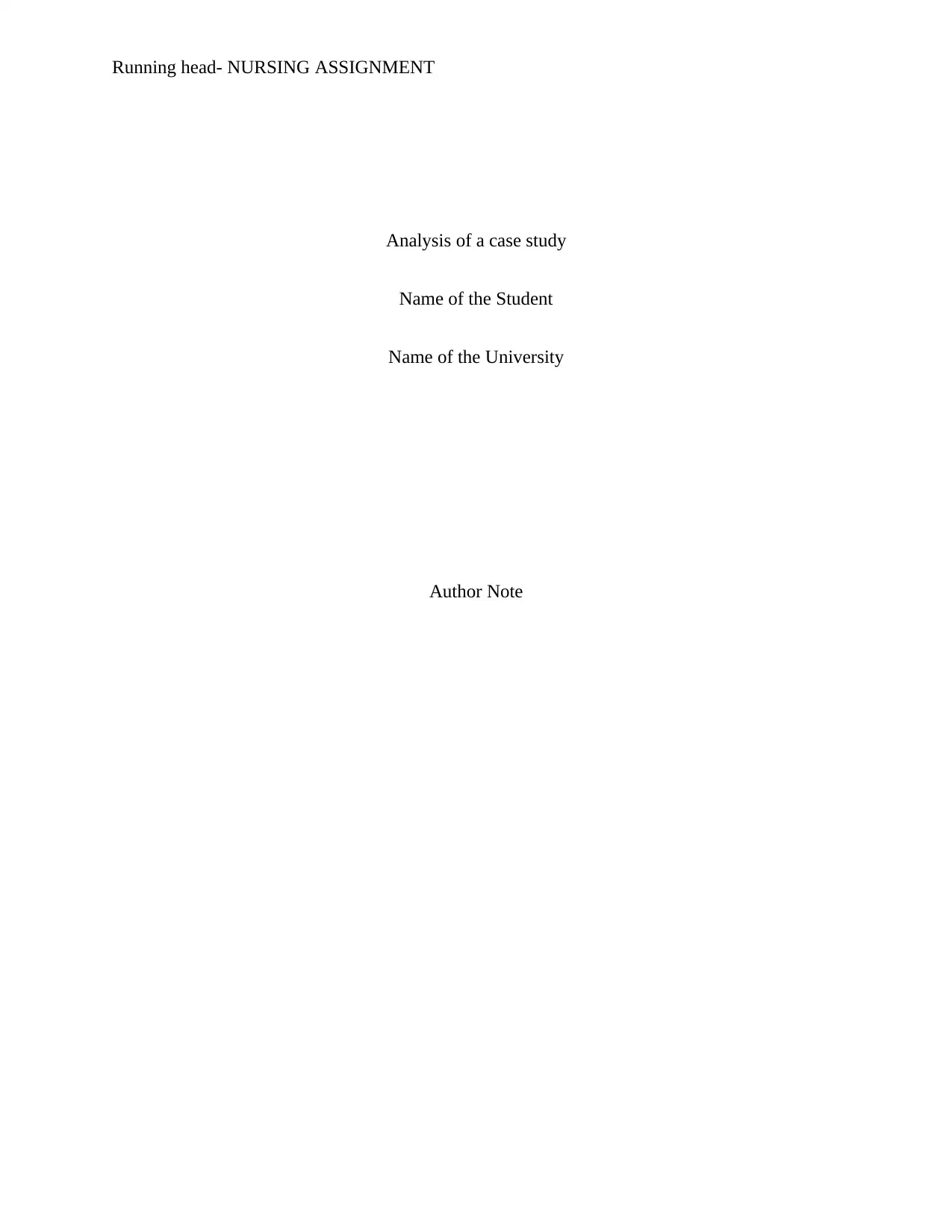
Running head- NURSING ASSIGNMENT
Analysis of a case study
Name of the Student
Name of the University
Author Note
Analysis of a case study
Name of the Student
Name of the University
Author Note
Secure Best Marks with AI Grader
Need help grading? Try our AI Grader for instant feedback on your assignments.

1NURSING ASSIGNMENT
The essay deals with case study that involves a female patient, Jane (pseudonym) who
had been diagnosed with sickle cell anaemia, at the age of 6 years. The patient is a Black British
and is 38 years old. The analysis of the case study will illustrate on the underlying risk factors
that contribute to the disease. It will further elaborate on the pathophysiology of sickle cell
anaemia the physical and psychological challenges faced by the patients and will discuss an
intensive nursing and medical care plan that will work towards providing optimal health
outcomes to the patient. Sickle cell anaemia is an inherited blood disorder that results in an
abnormality in the capacity of haemoglobin to carry oxygen. The disease is characterised by the
formation of rigid and sickle shaped red blood cells (Ware et al. 2017). It generally occurs when
2 abnormal copies of haemoglobin are inherited from each parent. It is estimated that sickle cell
anaemia approximately affects 12,500-15,000 people, in the UK. According to the National
Health Service, approximately 731,000 women were screened for sickle cell anaemia and
thalassaemia in England, during 2013-14 (NHS 2015). Furthermore, 668,000 infants were also
screened for the two diseases.
Around 12,500 individuals with SCD live in England. Of them, an estimated 9,000
people are residents of London. Therefore, the current statistics state that 1 in every 2,000 babies
in England are born with the condition (NHS 2015). Approximately, 3-5 million people are
globally affected by the disease and there are more than 300,000 births of babies, suffering from
sickle cell anaemia, every year. More than 70% of the births occur in the African continent (Piel
et al. 2013). Most commonly, individuals with a North-American origin are considered to be at
an increased risk of suffering from the blood disorder.
Research evidences and statistics state that the sickle cell traits are carried by an
estimated 300 million people all over the world. The highest prevalence of these traits is found in
The essay deals with case study that involves a female patient, Jane (pseudonym) who
had been diagnosed with sickle cell anaemia, at the age of 6 years. The patient is a Black British
and is 38 years old. The analysis of the case study will illustrate on the underlying risk factors
that contribute to the disease. It will further elaborate on the pathophysiology of sickle cell
anaemia the physical and psychological challenges faced by the patients and will discuss an
intensive nursing and medical care plan that will work towards providing optimal health
outcomes to the patient. Sickle cell anaemia is an inherited blood disorder that results in an
abnormality in the capacity of haemoglobin to carry oxygen. The disease is characterised by the
formation of rigid and sickle shaped red blood cells (Ware et al. 2017). It generally occurs when
2 abnormal copies of haemoglobin are inherited from each parent. It is estimated that sickle cell
anaemia approximately affects 12,500-15,000 people, in the UK. According to the National
Health Service, approximately 731,000 women were screened for sickle cell anaemia and
thalassaemia in England, during 2013-14 (NHS 2015). Furthermore, 668,000 infants were also
screened for the two diseases.
Around 12,500 individuals with SCD live in England. Of them, an estimated 9,000
people are residents of London. Therefore, the current statistics state that 1 in every 2,000 babies
in England are born with the condition (NHS 2015). Approximately, 3-5 million people are
globally affected by the disease and there are more than 300,000 births of babies, suffering from
sickle cell anaemia, every year. More than 70% of the births occur in the African continent (Piel
et al. 2013). Most commonly, individuals with a North-American origin are considered to be at
an increased risk of suffering from the blood disorder.
Research evidences and statistics state that the sickle cell traits are carried by an
estimated 300 million people all over the world. The highest prevalence of these traits is found in
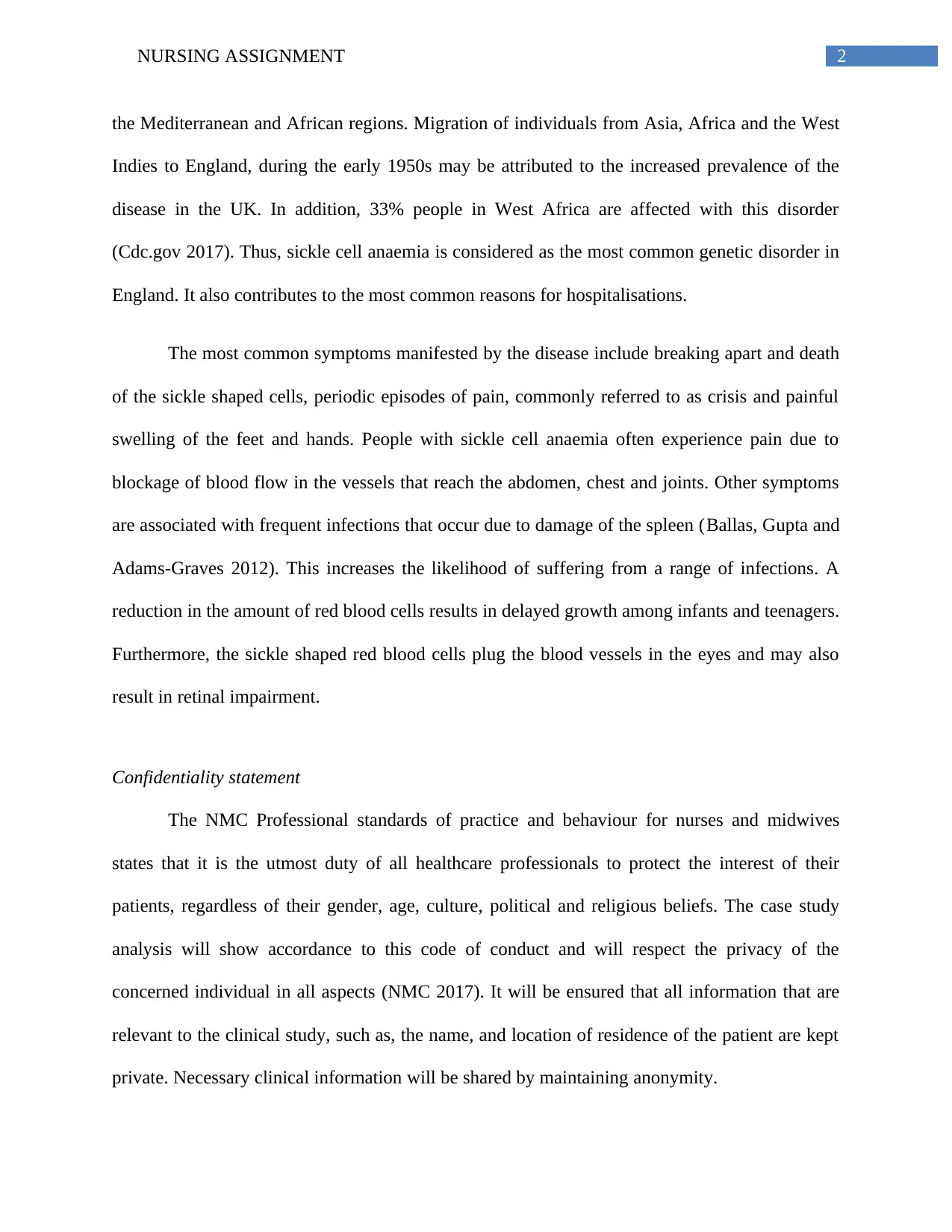
2NURSING ASSIGNMENT
the Mediterranean and African regions. Migration of individuals from Asia, Africa and the West
Indies to England, during the early 1950s may be attributed to the increased prevalence of the
disease in the UK. In addition, 33% people in West Africa are affected with this disorder
(Cdc.gov 2017). Thus, sickle cell anaemia is considered as the most common genetic disorder in
England. It also contributes to the most common reasons for hospitalisations.
The most common symptoms manifested by the disease include breaking apart and death
of the sickle shaped cells, periodic episodes of pain, commonly referred to as crisis and painful
swelling of the feet and hands. People with sickle cell anaemia often experience pain due to
blockage of blood flow in the vessels that reach the abdomen, chest and joints. Other symptoms
are associated with frequent infections that occur due to damage of the spleen (Ballas, Gupta and
Adams-Graves 2012). This increases the likelihood of suffering from a range of infections. A
reduction in the amount of red blood cells results in delayed growth among infants and teenagers.
Furthermore, the sickle shaped red blood cells plug the blood vessels in the eyes and may also
result in retinal impairment.
Confidentiality statement
The NMC Professional standards of practice and behaviour for nurses and midwives
states that it is the utmost duty of all healthcare professionals to protect the interest of their
patients, regardless of their gender, age, culture, political and religious beliefs. The case study
analysis will show accordance to this code of conduct and will respect the privacy of the
concerned individual in all aspects (NMC 2017). It will be ensured that all information that are
relevant to the clinical study, such as, the name, and location of residence of the patient are kept
private. Necessary clinical information will be shared by maintaining anonymity.
the Mediterranean and African regions. Migration of individuals from Asia, Africa and the West
Indies to England, during the early 1950s may be attributed to the increased prevalence of the
disease in the UK. In addition, 33% people in West Africa are affected with this disorder
(Cdc.gov 2017). Thus, sickle cell anaemia is considered as the most common genetic disorder in
England. It also contributes to the most common reasons for hospitalisations.
The most common symptoms manifested by the disease include breaking apart and death
of the sickle shaped cells, periodic episodes of pain, commonly referred to as crisis and painful
swelling of the feet and hands. People with sickle cell anaemia often experience pain due to
blockage of blood flow in the vessels that reach the abdomen, chest and joints. Other symptoms
are associated with frequent infections that occur due to damage of the spleen (Ballas, Gupta and
Adams-Graves 2012). This increases the likelihood of suffering from a range of infections. A
reduction in the amount of red blood cells results in delayed growth among infants and teenagers.
Furthermore, the sickle shaped red blood cells plug the blood vessels in the eyes and may also
result in retinal impairment.
Confidentiality statement
The NMC Professional standards of practice and behaviour for nurses and midwives
states that it is the utmost duty of all healthcare professionals to protect the interest of their
patients, regardless of their gender, age, culture, political and religious beliefs. The case study
analysis will show accordance to this code of conduct and will respect the privacy of the
concerned individual in all aspects (NMC 2017). It will be ensured that all information that are
relevant to the clinical study, such as, the name, and location of residence of the patient are kept
private. Necessary clinical information will be shared by maintaining anonymity.
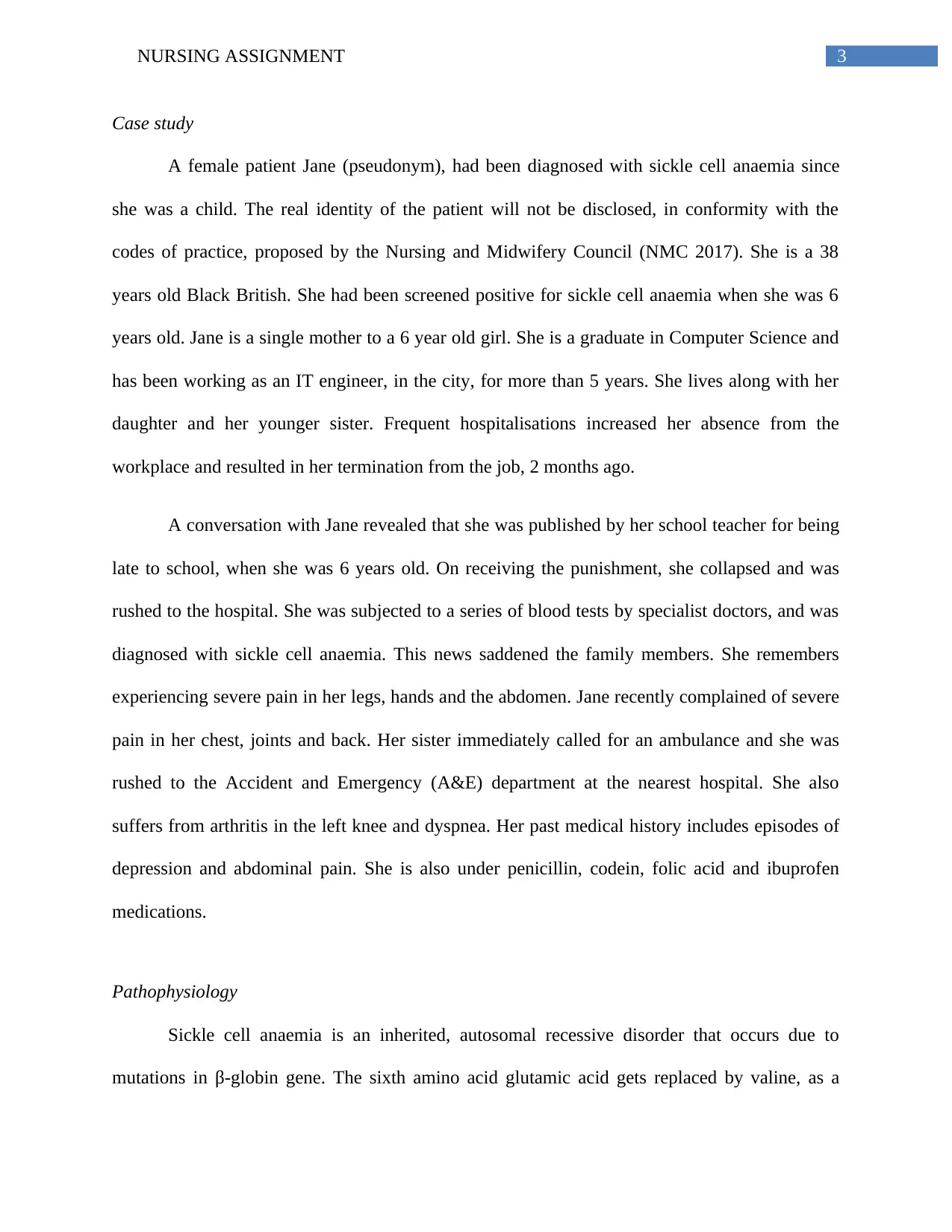
3NURSING ASSIGNMENT
Case study
A female patient Jane (pseudonym), had been diagnosed with sickle cell anaemia since
she was a child. The real identity of the patient will not be disclosed, in conformity with the
codes of practice, proposed by the Nursing and Midwifery Council (NMC 2017). She is a 38
years old Black British. She had been screened positive for sickle cell anaemia when she was 6
years old. Jane is a single mother to a 6 year old girl. She is a graduate in Computer Science and
has been working as an IT engineer, in the city, for more than 5 years. She lives along with her
daughter and her younger sister. Frequent hospitalisations increased her absence from the
workplace and resulted in her termination from the job, 2 months ago.
A conversation with Jane revealed that she was published by her school teacher for being
late to school, when she was 6 years old. On receiving the punishment, she collapsed and was
rushed to the hospital. She was subjected to a series of blood tests by specialist doctors, and was
diagnosed with sickle cell anaemia. This news saddened the family members. She remembers
experiencing severe pain in her legs, hands and the abdomen. Jane recently complained of severe
pain in her chest, joints and back. Her sister immediately called for an ambulance and she was
rushed to the Accident and Emergency (A&E) department at the nearest hospital. She also
suffers from arthritis in the left knee and dyspnea. Her past medical history includes episodes of
depression and abdominal pain. She is also under penicillin, codein, folic acid and ibuprofen
medications.
Pathophysiology
Sickle cell anaemia is an inherited, autosomal recessive disorder that occurs due to
mutations in β-globin gene. The sixth amino acid glutamic acid gets replaced by valine, as a
Case study
A female patient Jane (pseudonym), had been diagnosed with sickle cell anaemia since
she was a child. The real identity of the patient will not be disclosed, in conformity with the
codes of practice, proposed by the Nursing and Midwifery Council (NMC 2017). She is a 38
years old Black British. She had been screened positive for sickle cell anaemia when she was 6
years old. Jane is a single mother to a 6 year old girl. She is a graduate in Computer Science and
has been working as an IT engineer, in the city, for more than 5 years. She lives along with her
daughter and her younger sister. Frequent hospitalisations increased her absence from the
workplace and resulted in her termination from the job, 2 months ago.
A conversation with Jane revealed that she was published by her school teacher for being
late to school, when she was 6 years old. On receiving the punishment, she collapsed and was
rushed to the hospital. She was subjected to a series of blood tests by specialist doctors, and was
diagnosed with sickle cell anaemia. This news saddened the family members. She remembers
experiencing severe pain in her legs, hands and the abdomen. Jane recently complained of severe
pain in her chest, joints and back. Her sister immediately called for an ambulance and she was
rushed to the Accident and Emergency (A&E) department at the nearest hospital. She also
suffers from arthritis in the left knee and dyspnea. Her past medical history includes episodes of
depression and abdominal pain. She is also under penicillin, codein, folic acid and ibuprofen
medications.
Pathophysiology
Sickle cell anaemia is an inherited, autosomal recessive disorder that occurs due to
mutations in β-globin gene. The sixth amino acid glutamic acid gets replaced by valine, as a
Secure Best Marks with AI Grader
Need help grading? Try our AI Grader for instant feedback on your assignments.
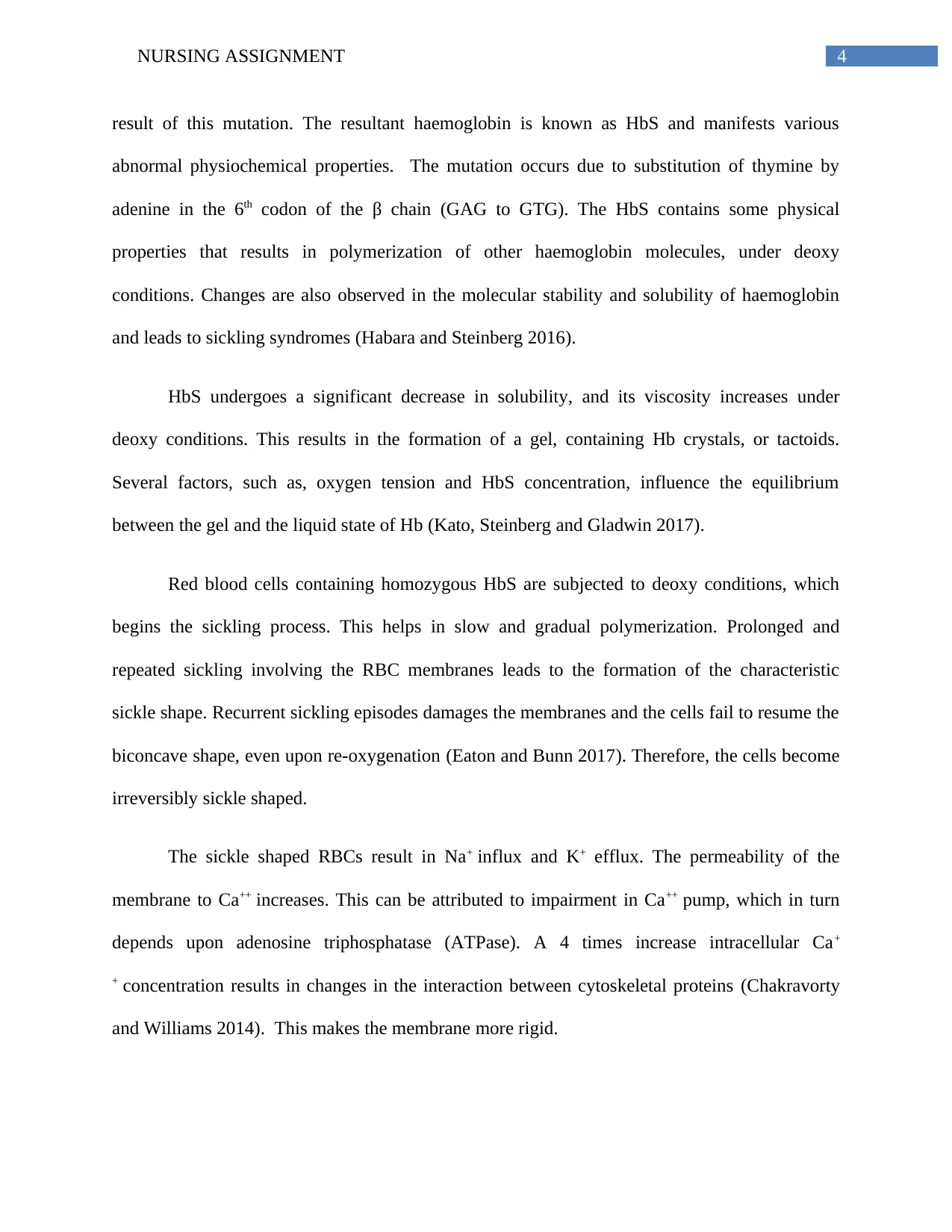
4NURSING ASSIGNMENT
result of this mutation. The resultant haemoglobin is known as HbS and manifests various
abnormal physiochemical properties. The mutation occurs due to substitution of thymine by
adenine in the 6th codon of the β chain (GAG to GTG). The HbS contains some physical
properties that results in polymerization of other haemoglobin molecules, under deoxy
conditions. Changes are also observed in the molecular stability and solubility of haemoglobin
and leads to sickling syndromes (Habara and Steinberg 2016).
HbS undergoes a significant decrease in solubility, and its viscosity increases under
deoxy conditions. This results in the formation of a gel, containing Hb crystals, or tactoids.
Several factors, such as, oxygen tension and HbS concentration, influence the equilibrium
between the gel and the liquid state of Hb (Kato, Steinberg and Gladwin 2017).
Red blood cells containing homozygous HbS are subjected to deoxy conditions, which
begins the sickling process. This helps in slow and gradual polymerization. Prolonged and
repeated sickling involving the RBC membranes leads to the formation of the characteristic
sickle shape. Recurrent sickling episodes damages the membranes and the cells fail to resume the
biconcave shape, even upon re-oxygenation (Eaton and Bunn 2017). Therefore, the cells become
irreversibly sickle shaped.
The sickle shaped RBCs result in Na+ influx and K+ efflux. The permeability of the
membrane to Ca++ increases. This can be attributed to impairment in Ca++ pump, which in turn
depends upon adenosine triphosphatase (ATPase). A 4 times increase intracellular Ca+
+ concentration results in changes in the interaction between cytoskeletal proteins (Chakravorty
and Williams 2014). This makes the membrane more rigid.
result of this mutation. The resultant haemoglobin is known as HbS and manifests various
abnormal physiochemical properties. The mutation occurs due to substitution of thymine by
adenine in the 6th codon of the β chain (GAG to GTG). The HbS contains some physical
properties that results in polymerization of other haemoglobin molecules, under deoxy
conditions. Changes are also observed in the molecular stability and solubility of haemoglobin
and leads to sickling syndromes (Habara and Steinberg 2016).
HbS undergoes a significant decrease in solubility, and its viscosity increases under
deoxy conditions. This results in the formation of a gel, containing Hb crystals, or tactoids.
Several factors, such as, oxygen tension and HbS concentration, influence the equilibrium
between the gel and the liquid state of Hb (Kato, Steinberg and Gladwin 2017).
Red blood cells containing homozygous HbS are subjected to deoxy conditions, which
begins the sickling process. This helps in slow and gradual polymerization. Prolonged and
repeated sickling involving the RBC membranes leads to the formation of the characteristic
sickle shape. Recurrent sickling episodes damages the membranes and the cells fail to resume the
biconcave shape, even upon re-oxygenation (Eaton and Bunn 2017). Therefore, the cells become
irreversibly sickle shaped.
The sickle shaped RBCs result in Na+ influx and K+ efflux. The permeability of the
membrane to Ca++ increases. This can be attributed to impairment in Ca++ pump, which in turn
depends upon adenosine triphosphatase (ATPase). A 4 times increase intracellular Ca+
+ concentration results in changes in the interaction between cytoskeletal proteins (Chakravorty
and Williams 2014). This makes the membrane more rigid.
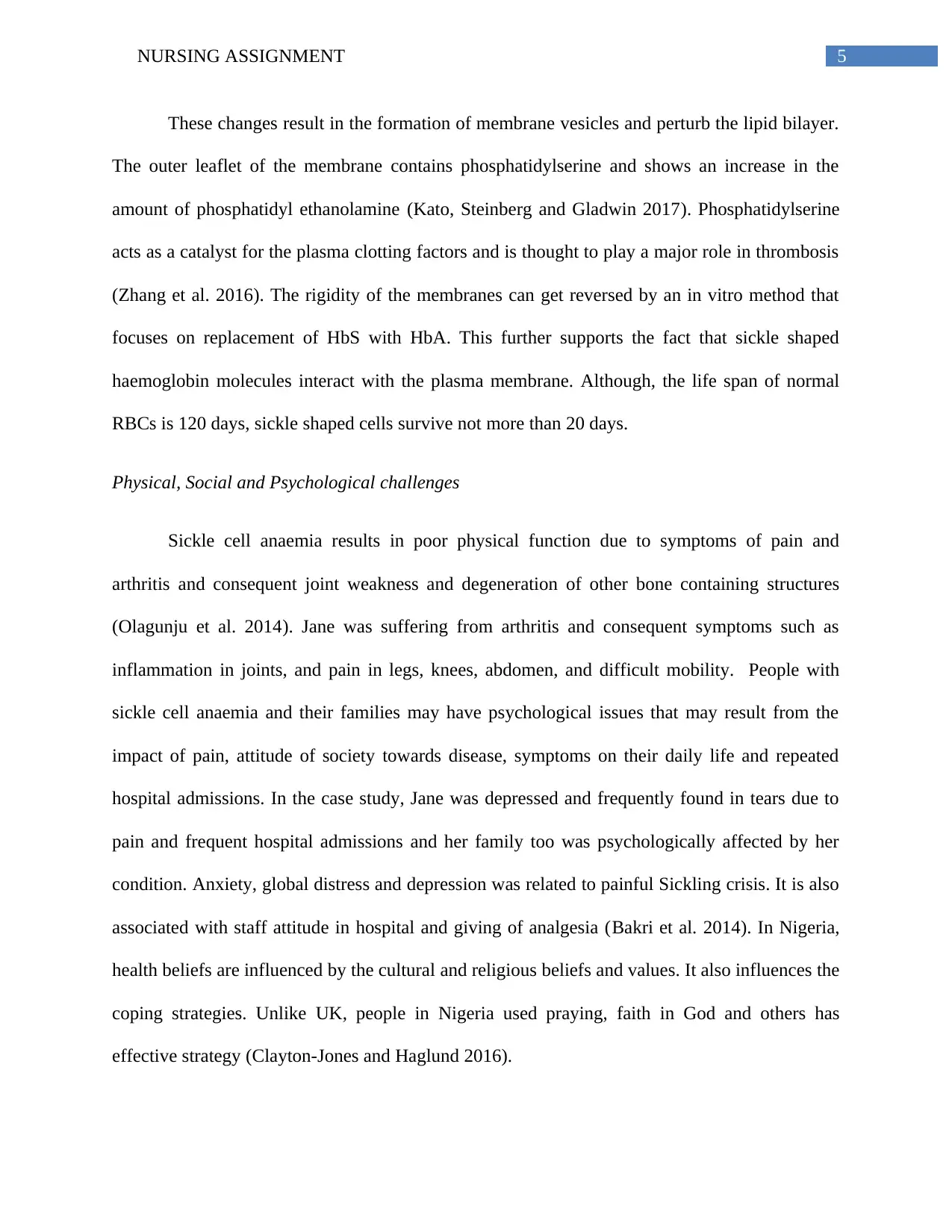
5NURSING ASSIGNMENT
These changes result in the formation of membrane vesicles and perturb the lipid bilayer.
The outer leaflet of the membrane contains phosphatidylserine and shows an increase in the
amount of phosphatidyl ethanolamine (Kato, Steinberg and Gladwin 2017). Phosphatidylserine
acts as a catalyst for the plasma clotting factors and is thought to play a major role in thrombosis
(Zhang et al. 2016). The rigidity of the membranes can get reversed by an in vitro method that
focuses on replacement of HbS with HbA. This further supports the fact that sickle shaped
haemoglobin molecules interact with the plasma membrane. Although, the life span of normal
RBCs is 120 days, sickle shaped cells survive not more than 20 days.
Physical, Social and Psychological challenges
Sickle cell anaemia results in poor physical function due to symptoms of pain and
arthritis and consequent joint weakness and degeneration of other bone containing structures
(Olagunju et al. 2014). Jane was suffering from arthritis and consequent symptoms such as
inflammation in joints, and pain in legs, knees, abdomen, and difficult mobility. People with
sickle cell anaemia and their families may have psychological issues that may result from the
impact of pain, attitude of society towards disease, symptoms on their daily life and repeated
hospital admissions. In the case study, Jane was depressed and frequently found in tears due to
pain and frequent hospital admissions and her family too was psychologically affected by her
condition. Anxiety, global distress and depression was related to painful Sickling crisis. It is also
associated with staff attitude in hospital and giving of analgesia (Bakri et al. 2014). In Nigeria,
health beliefs are influenced by the cultural and religious beliefs and values. It also influences the
coping strategies. Unlike UK, people in Nigeria used praying, faith in God and others has
effective strategy (Clayton-Jones and Haglund 2016).
These changes result in the formation of membrane vesicles and perturb the lipid bilayer.
The outer leaflet of the membrane contains phosphatidylserine and shows an increase in the
amount of phosphatidyl ethanolamine (Kato, Steinberg and Gladwin 2017). Phosphatidylserine
acts as a catalyst for the plasma clotting factors and is thought to play a major role in thrombosis
(Zhang et al. 2016). The rigidity of the membranes can get reversed by an in vitro method that
focuses on replacement of HbS with HbA. This further supports the fact that sickle shaped
haemoglobin molecules interact with the plasma membrane. Although, the life span of normal
RBCs is 120 days, sickle shaped cells survive not more than 20 days.
Physical, Social and Psychological challenges
Sickle cell anaemia results in poor physical function due to symptoms of pain and
arthritis and consequent joint weakness and degeneration of other bone containing structures
(Olagunju et al. 2014). Jane was suffering from arthritis and consequent symptoms such as
inflammation in joints, and pain in legs, knees, abdomen, and difficult mobility. People with
sickle cell anaemia and their families may have psychological issues that may result from the
impact of pain, attitude of society towards disease, symptoms on their daily life and repeated
hospital admissions. In the case study, Jane was depressed and frequently found in tears due to
pain and frequent hospital admissions and her family too was psychologically affected by her
condition. Anxiety, global distress and depression was related to painful Sickling crisis. It is also
associated with staff attitude in hospital and giving of analgesia (Bakri et al. 2014). In Nigeria,
health beliefs are influenced by the cultural and religious beliefs and values. It also influences the
coping strategies. Unlike UK, people in Nigeria used praying, faith in God and others has
effective strategy (Clayton-Jones and Haglund 2016).
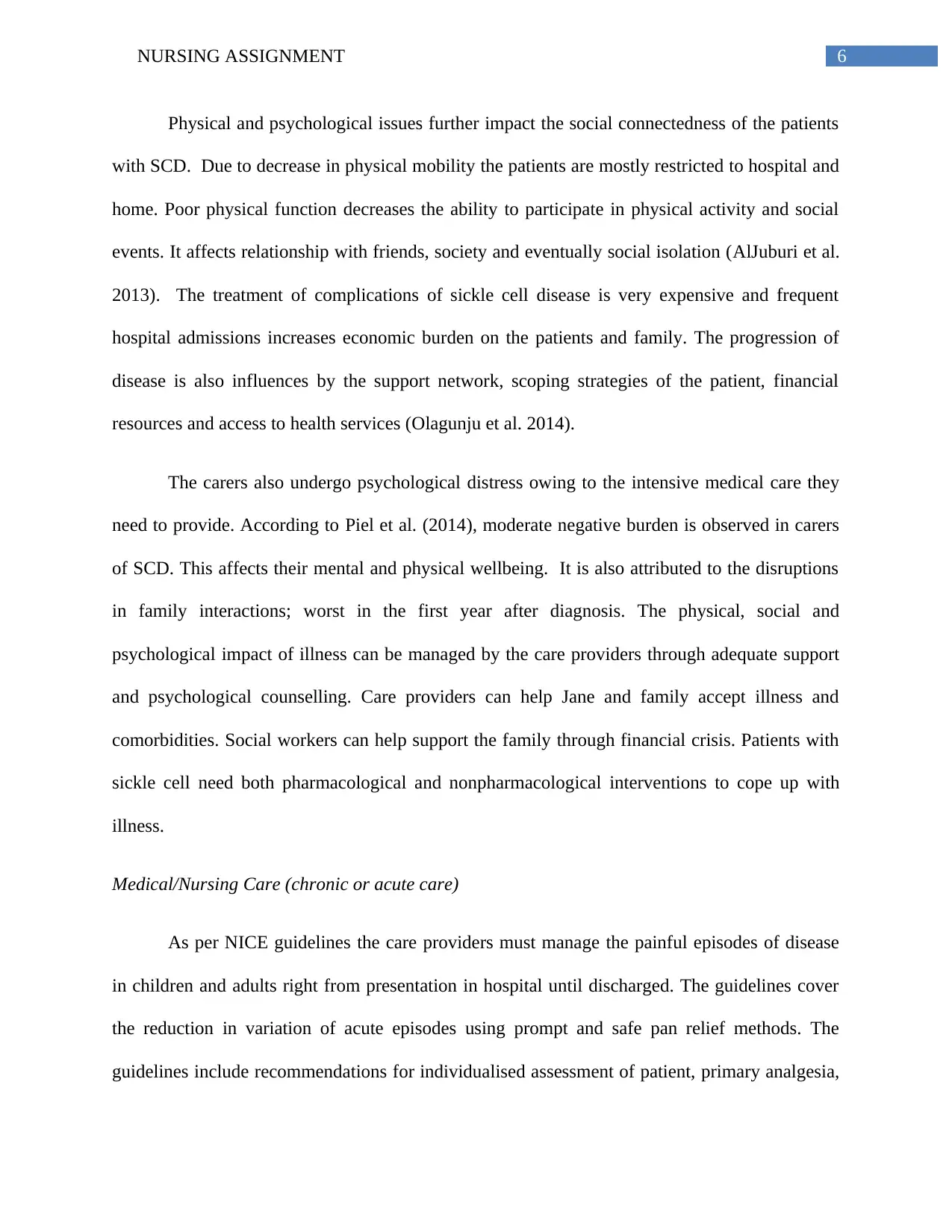
6NURSING ASSIGNMENT
Physical and psychological issues further impact the social connectedness of the patients
with SCD. Due to decrease in physical mobility the patients are mostly restricted to hospital and
home. Poor physical function decreases the ability to participate in physical activity and social
events. It affects relationship with friends, society and eventually social isolation (AlJuburi et al.
2013). The treatment of complications of sickle cell disease is very expensive and frequent
hospital admissions increases economic burden on the patients and family. The progression of
disease is also influences by the support network, scoping strategies of the patient, financial
resources and access to health services (Olagunju et al. 2014).
The carers also undergo psychological distress owing to the intensive medical care they
need to provide. According to Piel et al. (2014), moderate negative burden is observed in carers
of SCD. This affects their mental and physical wellbeing. It is also attributed to the disruptions
in family interactions; worst in the first year after diagnosis. The physical, social and
psychological impact of illness can be managed by the care providers through adequate support
and psychological counselling. Care providers can help Jane and family accept illness and
comorbidities. Social workers can help support the family through financial crisis. Patients with
sickle cell need both pharmacological and nonpharmacological interventions to cope up with
illness.
Medical/Nursing Care (chronic or acute care)
As per NICE guidelines the care providers must manage the painful episodes of disease
in children and adults right from presentation in hospital until discharged. The guidelines cover
the reduction in variation of acute episodes using prompt and safe pan relief methods. The
guidelines include recommendations for individualised assessment of patient, primary analgesia,
Physical and psychological issues further impact the social connectedness of the patients
with SCD. Due to decrease in physical mobility the patients are mostly restricted to hospital and
home. Poor physical function decreases the ability to participate in physical activity and social
events. It affects relationship with friends, society and eventually social isolation (AlJuburi et al.
2013). The treatment of complications of sickle cell disease is very expensive and frequent
hospital admissions increases economic burden on the patients and family. The progression of
disease is also influences by the support network, scoping strategies of the patient, financial
resources and access to health services (Olagunju et al. 2014).
The carers also undergo psychological distress owing to the intensive medical care they
need to provide. According to Piel et al. (2014), moderate negative burden is observed in carers
of SCD. This affects their mental and physical wellbeing. It is also attributed to the disruptions
in family interactions; worst in the first year after diagnosis. The physical, social and
psychological impact of illness can be managed by the care providers through adequate support
and psychological counselling. Care providers can help Jane and family accept illness and
comorbidities. Social workers can help support the family through financial crisis. Patients with
sickle cell need both pharmacological and nonpharmacological interventions to cope up with
illness.
Medical/Nursing Care (chronic or acute care)
As per NICE guidelines the care providers must manage the painful episodes of disease
in children and adults right from presentation in hospital until discharged. The guidelines cover
the reduction in variation of acute episodes using prompt and safe pan relief methods. The
guidelines include recommendations for individualised assessment of patient, primary analgesia,
Paraphrase This Document
Need a fresh take? Get an instant paraphrase of this document with our AI Paraphraser
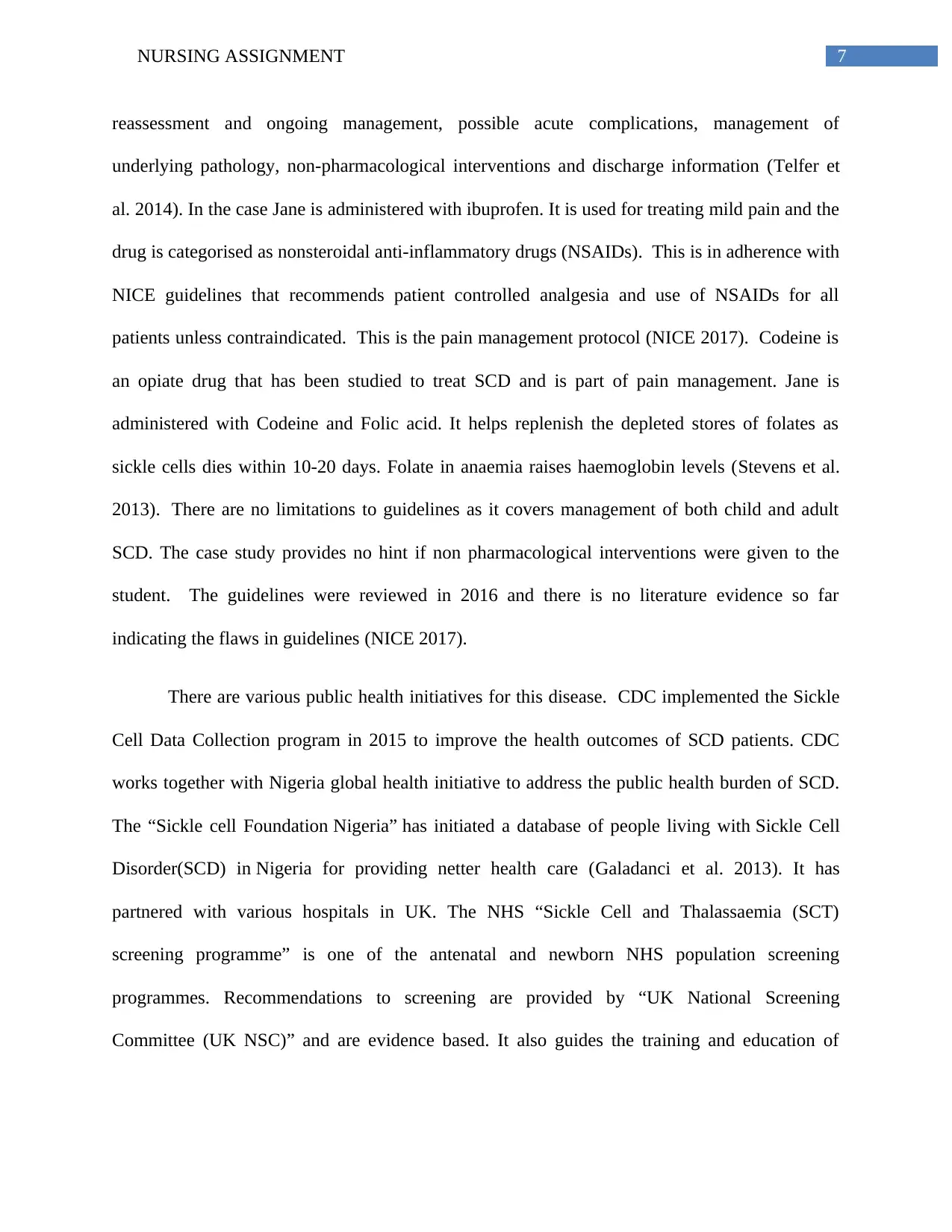
7NURSING ASSIGNMENT
reassessment and ongoing management, possible acute complications, management of
underlying pathology, non-pharmacological interventions and discharge information (Telfer et
al. 2014). In the case Jane is administered with ibuprofen. It is used for treating mild pain and the
drug is categorised as nonsteroidal anti-inflammatory drugs (NSAIDs). This is in adherence with
NICE guidelines that recommends patient controlled analgesia and use of NSAIDs for all
patients unless contraindicated. This is the pain management protocol (NICE 2017). Codeine is
an opiate drug that has been studied to treat SCD and is part of pain management. Jane is
administered with Codeine and Folic acid. It helps replenish the depleted stores of folates as
sickle cells dies within 10-20 days. Folate in anaemia raises haemoglobin levels (Stevens et al.
2013). There are no limitations to guidelines as it covers management of both child and adult
SCD. The case study provides no hint if non pharmacological interventions were given to the
student. The guidelines were reviewed in 2016 and there is no literature evidence so far
indicating the flaws in guidelines (NICE 2017).
There are various public health initiatives for this disease. CDC implemented the Sickle
Cell Data Collection program in 2015 to improve the health outcomes of SCD patients. CDC
works together with Nigeria global health initiative to address the public health burden of SCD.
The “Sickle cell Foundation Nigeria” has initiated a database of people living with Sickle Cell
Disorder(SCD) in Nigeria for providing netter health care (Galadanci et al. 2013). It has
partnered with various hospitals in UK. The NHS “Sickle Cell and Thalassaemia (SCT)
screening programme” is one of the antenatal and newborn NHS population screening
programmes. Recommendations to screening are provided by “UK National Screening
Committee (UK NSC)” and are evidence based. It also guides the training and education of
reassessment and ongoing management, possible acute complications, management of
underlying pathology, non-pharmacological interventions and discharge information (Telfer et
al. 2014). In the case Jane is administered with ibuprofen. It is used for treating mild pain and the
drug is categorised as nonsteroidal anti-inflammatory drugs (NSAIDs). This is in adherence with
NICE guidelines that recommends patient controlled analgesia and use of NSAIDs for all
patients unless contraindicated. This is the pain management protocol (NICE 2017). Codeine is
an opiate drug that has been studied to treat SCD and is part of pain management. Jane is
administered with Codeine and Folic acid. It helps replenish the depleted stores of folates as
sickle cells dies within 10-20 days. Folate in anaemia raises haemoglobin levels (Stevens et al.
2013). There are no limitations to guidelines as it covers management of both child and adult
SCD. The case study provides no hint if non pharmacological interventions were given to the
student. The guidelines were reviewed in 2016 and there is no literature evidence so far
indicating the flaws in guidelines (NICE 2017).
There are various public health initiatives for this disease. CDC implemented the Sickle
Cell Data Collection program in 2015 to improve the health outcomes of SCD patients. CDC
works together with Nigeria global health initiative to address the public health burden of SCD.
The “Sickle cell Foundation Nigeria” has initiated a database of people living with Sickle Cell
Disorder(SCD) in Nigeria for providing netter health care (Galadanci et al. 2013). It has
partnered with various hospitals in UK. The NHS “Sickle Cell and Thalassaemia (SCT)
screening programme” is one of the antenatal and newborn NHS population screening
programmes. Recommendations to screening are provided by “UK National Screening
Committee (UK NSC)” and are evidence based. It also guides the training and education of
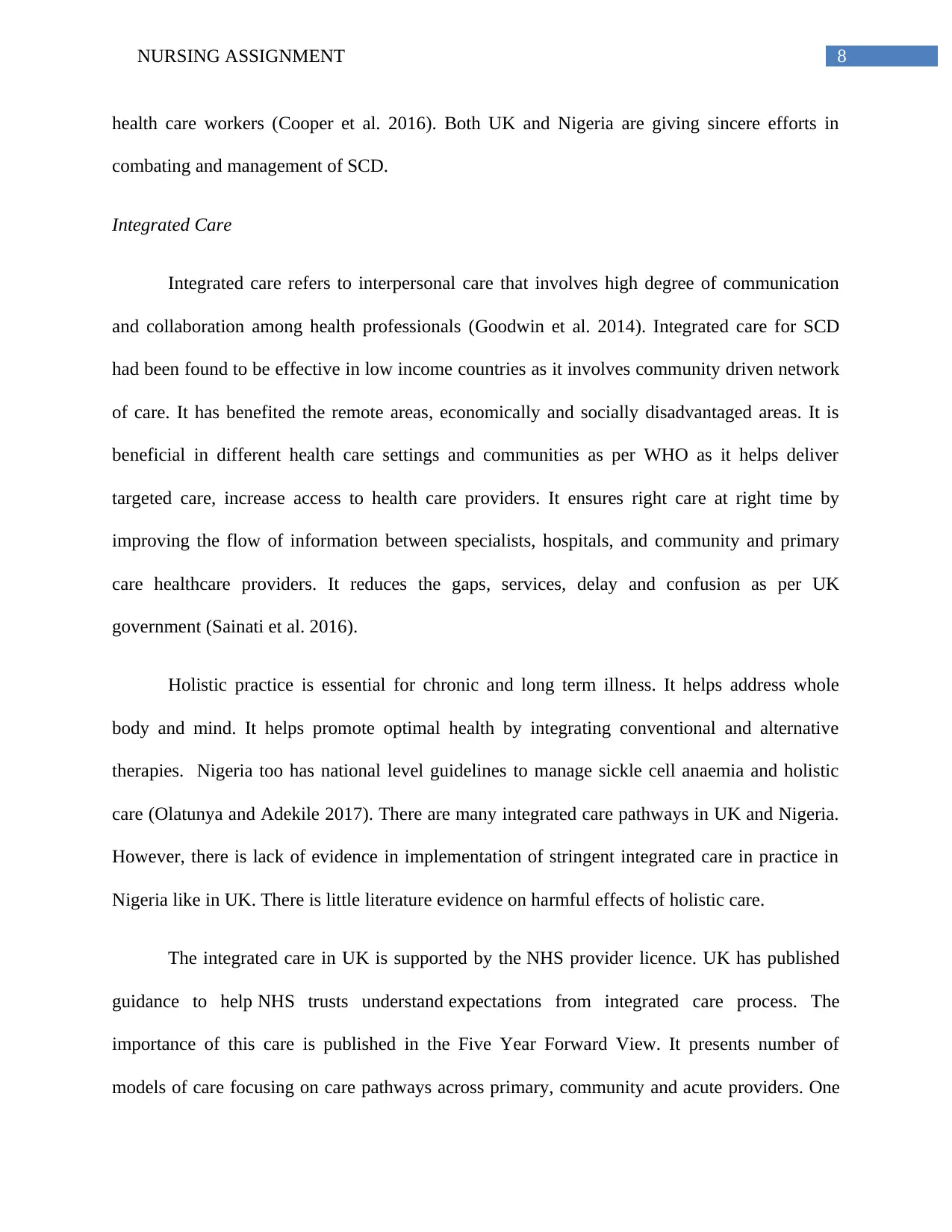
8NURSING ASSIGNMENT
health care workers (Cooper et al. 2016). Both UK and Nigeria are giving sincere efforts in
combating and management of SCD.
Integrated Care
Integrated care refers to interpersonal care that involves high degree of communication
and collaboration among health professionals (Goodwin et al. 2014). Integrated care for SCD
had been found to be effective in low income countries as it involves community driven network
of care. It has benefited the remote areas, economically and socially disadvantaged areas. It is
beneficial in different health care settings and communities as per WHO as it helps deliver
targeted care, increase access to health care providers. It ensures right care at right time by
improving the flow of information between specialists, hospitals, and community and primary
care healthcare providers. It reduces the gaps, services, delay and confusion as per UK
government (Sainati et al. 2016).
Holistic practice is essential for chronic and long term illness. It helps address whole
body and mind. It helps promote optimal health by integrating conventional and alternative
therapies. Nigeria too has national level guidelines to manage sickle cell anaemia and holistic
care (Olatunya and Adekile 2017). There are many integrated care pathways in UK and Nigeria.
However, there is lack of evidence in implementation of stringent integrated care in practice in
Nigeria like in UK. There is little literature evidence on harmful effects of holistic care.
The integrated care in UK is supported by the NHS provider licence. UK has published
guidance to help NHS trusts understand expectations from integrated care process. The
importance of this care is published in the Five Year Forward View. It presents number of
models of care focusing on care pathways across primary, community and acute providers. One
health care workers (Cooper et al. 2016). Both UK and Nigeria are giving sincere efforts in
combating and management of SCD.
Integrated Care
Integrated care refers to interpersonal care that involves high degree of communication
and collaboration among health professionals (Goodwin et al. 2014). Integrated care for SCD
had been found to be effective in low income countries as it involves community driven network
of care. It has benefited the remote areas, economically and socially disadvantaged areas. It is
beneficial in different health care settings and communities as per WHO as it helps deliver
targeted care, increase access to health care providers. It ensures right care at right time by
improving the flow of information between specialists, hospitals, and community and primary
care healthcare providers. It reduces the gaps, services, delay and confusion as per UK
government (Sainati et al. 2016).
Holistic practice is essential for chronic and long term illness. It helps address whole
body and mind. It helps promote optimal health by integrating conventional and alternative
therapies. Nigeria too has national level guidelines to manage sickle cell anaemia and holistic
care (Olatunya and Adekile 2017). There are many integrated care pathways in UK and Nigeria.
However, there is lack of evidence in implementation of stringent integrated care in practice in
Nigeria like in UK. There is little literature evidence on harmful effects of holistic care.
The integrated care in UK is supported by the NHS provider licence. UK has published
guidance to help NHS trusts understand expectations from integrated care process. The
importance of this care is published in the Five Year Forward View. It presents number of
models of care focusing on care pathways across primary, community and acute providers. One
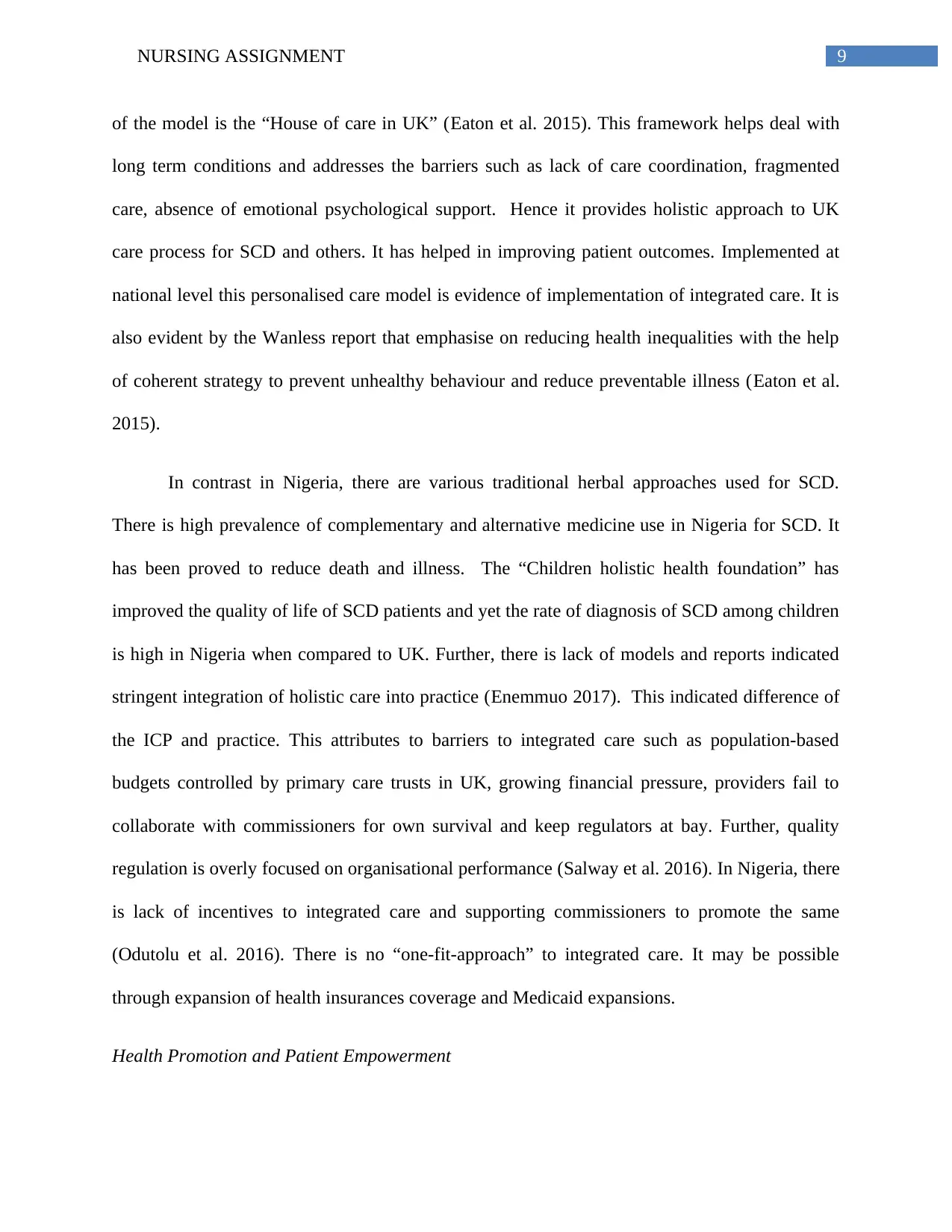
9NURSING ASSIGNMENT
of the model is the “House of care in UK” (Eaton et al. 2015). This framework helps deal with
long term conditions and addresses the barriers such as lack of care coordination, fragmented
care, absence of emotional psychological support. Hence it provides holistic approach to UK
care process for SCD and others. It has helped in improving patient outcomes. Implemented at
national level this personalised care model is evidence of implementation of integrated care. It is
also evident by the Wanless report that emphasise on reducing health inequalities with the help
of coherent strategy to prevent unhealthy behaviour and reduce preventable illness (Eaton et al.
2015).
In contrast in Nigeria, there are various traditional herbal approaches used for SCD.
There is high prevalence of complementary and alternative medicine use in Nigeria for SCD. It
has been proved to reduce death and illness. The “Children holistic health foundation” has
improved the quality of life of SCD patients and yet the rate of diagnosis of SCD among children
is high in Nigeria when compared to UK. Further, there is lack of models and reports indicated
stringent integration of holistic care into practice (Enemmuo 2017). This indicated difference of
the ICP and practice. This attributes to barriers to integrated care such as population-based
budgets controlled by primary care trusts in UK, growing financial pressure, providers fail to
collaborate with commissioners for own survival and keep regulators at bay. Further, quality
regulation is overly focused on organisational performance (Salway et al. 2016). In Nigeria, there
is lack of incentives to integrated care and supporting commissioners to promote the same
(Odutolu et al. 2016). There is no “one-fit-approach” to integrated care. It may be possible
through expansion of health insurances coverage and Medicaid expansions.
Health Promotion and Patient Empowerment
of the model is the “House of care in UK” (Eaton et al. 2015). This framework helps deal with
long term conditions and addresses the barriers such as lack of care coordination, fragmented
care, absence of emotional psychological support. Hence it provides holistic approach to UK
care process for SCD and others. It has helped in improving patient outcomes. Implemented at
national level this personalised care model is evidence of implementation of integrated care. It is
also evident by the Wanless report that emphasise on reducing health inequalities with the help
of coherent strategy to prevent unhealthy behaviour and reduce preventable illness (Eaton et al.
2015).
In contrast in Nigeria, there are various traditional herbal approaches used for SCD.
There is high prevalence of complementary and alternative medicine use in Nigeria for SCD. It
has been proved to reduce death and illness. The “Children holistic health foundation” has
improved the quality of life of SCD patients and yet the rate of diagnosis of SCD among children
is high in Nigeria when compared to UK. Further, there is lack of models and reports indicated
stringent integration of holistic care into practice (Enemmuo 2017). This indicated difference of
the ICP and practice. This attributes to barriers to integrated care such as population-based
budgets controlled by primary care trusts in UK, growing financial pressure, providers fail to
collaborate with commissioners for own survival and keep regulators at bay. Further, quality
regulation is overly focused on organisational performance (Salway et al. 2016). In Nigeria, there
is lack of incentives to integrated care and supporting commissioners to promote the same
(Odutolu et al. 2016). There is no “one-fit-approach” to integrated care. It may be possible
through expansion of health insurances coverage and Medicaid expansions.
Health Promotion and Patient Empowerment
Secure Best Marks with AI Grader
Need help grading? Try our AI Grader for instant feedback on your assignments.
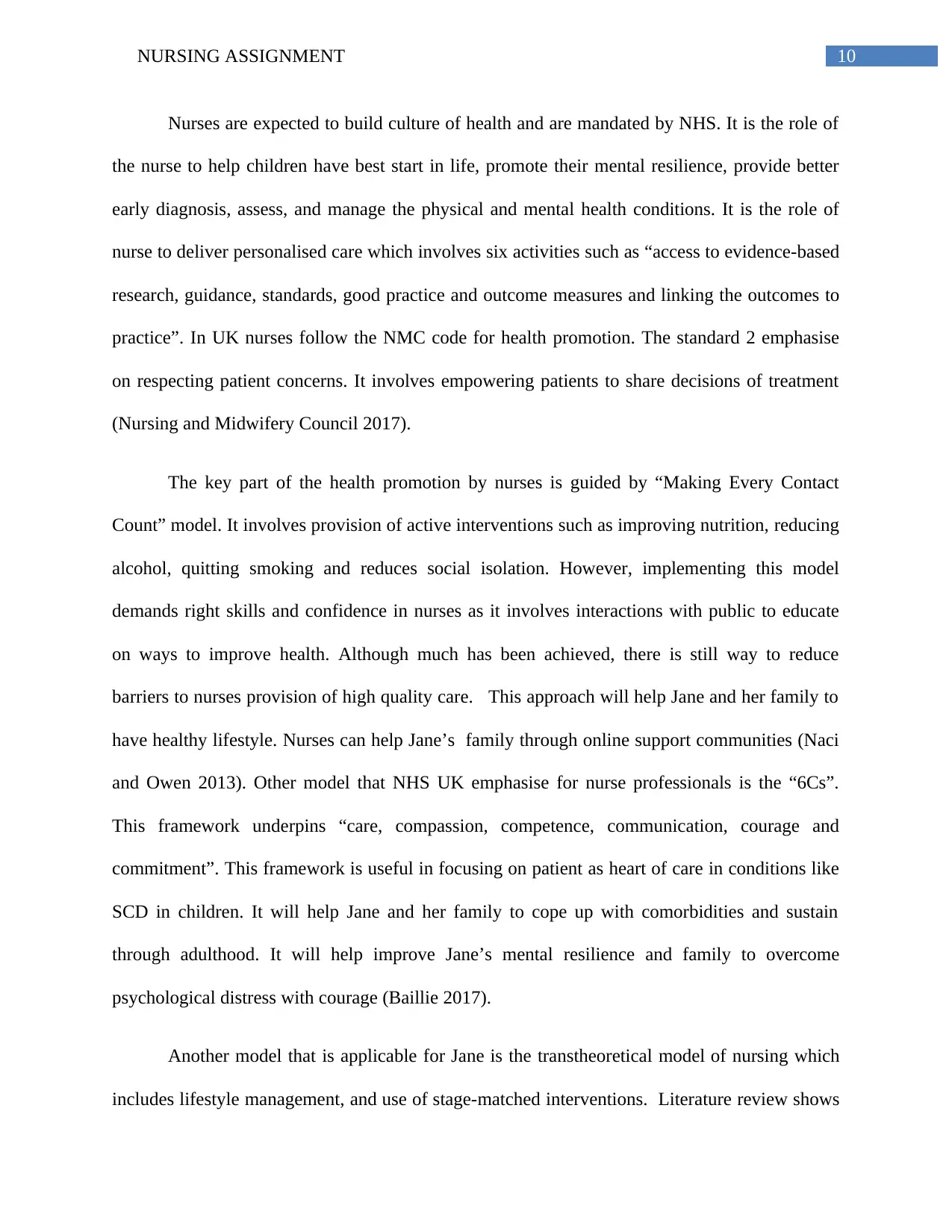
10NURSING ASSIGNMENT
Nurses are expected to build culture of health and are mandated by NHS. It is the role of
the nurse to help children have best start in life, promote their mental resilience, provide better
early diagnosis, assess, and manage the physical and mental health conditions. It is the role of
nurse to deliver personalised care which involves six activities such as “access to evidence-based
research, guidance, standards, good practice and outcome measures and linking the outcomes to
practice”. In UK nurses follow the NMC code for health promotion. The standard 2 emphasise
on respecting patient concerns. It involves empowering patients to share decisions of treatment
(Nursing and Midwifery Council 2017).
The key part of the health promotion by nurses is guided by “Making Every Contact
Count” model. It involves provision of active interventions such as improving nutrition, reducing
alcohol, quitting smoking and reduces social isolation. However, implementing this model
demands right skills and confidence in nurses as it involves interactions with public to educate
on ways to improve health. Although much has been achieved, there is still way to reduce
barriers to nurses provision of high quality care. This approach will help Jane and her family to
have healthy lifestyle. Nurses can help Jane’s family through online support communities (Naci
and Owen 2013). Other model that NHS UK emphasise for nurse professionals is the “6Cs”.
This framework underpins “care, compassion, competence, communication, courage and
commitment”. This framework is useful in focusing on patient as heart of care in conditions like
SCD in children. It will help Jane and her family to cope up with comorbidities and sustain
through adulthood. It will help improve Jane’s mental resilience and family to overcome
psychological distress with courage (Baillie 2017).
Another model that is applicable for Jane is the transtheoretical model of nursing which
includes lifestyle management, and use of stage-matched interventions. Literature review shows
Nurses are expected to build culture of health and are mandated by NHS. It is the role of
the nurse to help children have best start in life, promote their mental resilience, provide better
early diagnosis, assess, and manage the physical and mental health conditions. It is the role of
nurse to deliver personalised care which involves six activities such as “access to evidence-based
research, guidance, standards, good practice and outcome measures and linking the outcomes to
practice”. In UK nurses follow the NMC code for health promotion. The standard 2 emphasise
on respecting patient concerns. It involves empowering patients to share decisions of treatment
(Nursing and Midwifery Council 2017).
The key part of the health promotion by nurses is guided by “Making Every Contact
Count” model. It involves provision of active interventions such as improving nutrition, reducing
alcohol, quitting smoking and reduces social isolation. However, implementing this model
demands right skills and confidence in nurses as it involves interactions with public to educate
on ways to improve health. Although much has been achieved, there is still way to reduce
barriers to nurses provision of high quality care. This approach will help Jane and her family to
have healthy lifestyle. Nurses can help Jane’s family through online support communities (Naci
and Owen 2013). Other model that NHS UK emphasise for nurse professionals is the “6Cs”.
This framework underpins “care, compassion, competence, communication, courage and
commitment”. This framework is useful in focusing on patient as heart of care in conditions like
SCD in children. It will help Jane and her family to cope up with comorbidities and sustain
through adulthood. It will help improve Jane’s mental resilience and family to overcome
psychological distress with courage (Baillie 2017).
Another model that is applicable for Jane is the transtheoretical model of nursing which
includes lifestyle management, and use of stage-matched interventions. Literature review shows
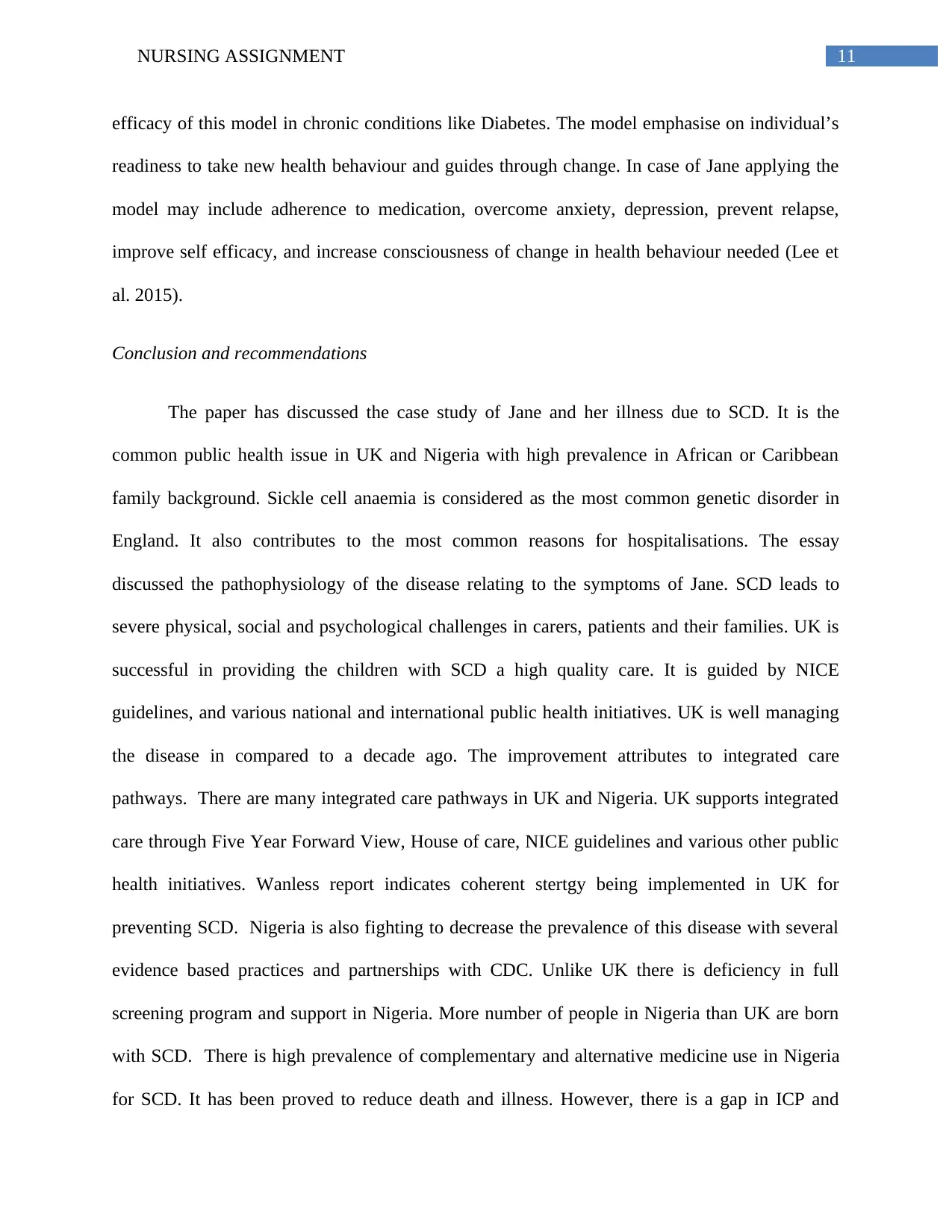
11NURSING ASSIGNMENT
efficacy of this model in chronic conditions like Diabetes. The model emphasise on individual’s
readiness to take new health behaviour and guides through change. In case of Jane applying the
model may include adherence to medication, overcome anxiety, depression, prevent relapse,
improve self efficacy, and increase consciousness of change in health behaviour needed (Lee et
al. 2015).
Conclusion and recommendations
The paper has discussed the case study of Jane and her illness due to SCD. It is the
common public health issue in UK and Nigeria with high prevalence in African or Caribbean
family background. Sickle cell anaemia is considered as the most common genetic disorder in
England. It also contributes to the most common reasons for hospitalisations. The essay
discussed the pathophysiology of the disease relating to the symptoms of Jane. SCD leads to
severe physical, social and psychological challenges in carers, patients and their families. UK is
successful in providing the children with SCD a high quality care. It is guided by NICE
guidelines, and various national and international public health initiatives. UK is well managing
the disease in compared to a decade ago. The improvement attributes to integrated care
pathways. There are many integrated care pathways in UK and Nigeria. UK supports integrated
care through Five Year Forward View, House of care, NICE guidelines and various other public
health initiatives. Wanless report indicates coherent stertgy being implemented in UK for
preventing SCD. Nigeria is also fighting to decrease the prevalence of this disease with several
evidence based practices and partnerships with CDC. Unlike UK there is deficiency in full
screening program and support in Nigeria. More number of people in Nigeria than UK are born
with SCD. There is high prevalence of complementary and alternative medicine use in Nigeria
for SCD. It has been proved to reduce death and illness. However, there is a gap in ICP and
efficacy of this model in chronic conditions like Diabetes. The model emphasise on individual’s
readiness to take new health behaviour and guides through change. In case of Jane applying the
model may include adherence to medication, overcome anxiety, depression, prevent relapse,
improve self efficacy, and increase consciousness of change in health behaviour needed (Lee et
al. 2015).
Conclusion and recommendations
The paper has discussed the case study of Jane and her illness due to SCD. It is the
common public health issue in UK and Nigeria with high prevalence in African or Caribbean
family background. Sickle cell anaemia is considered as the most common genetic disorder in
England. It also contributes to the most common reasons for hospitalisations. The essay
discussed the pathophysiology of the disease relating to the symptoms of Jane. SCD leads to
severe physical, social and psychological challenges in carers, patients and their families. UK is
successful in providing the children with SCD a high quality care. It is guided by NICE
guidelines, and various national and international public health initiatives. UK is well managing
the disease in compared to a decade ago. The improvement attributes to integrated care
pathways. There are many integrated care pathways in UK and Nigeria. UK supports integrated
care through Five Year Forward View, House of care, NICE guidelines and various other public
health initiatives. Wanless report indicates coherent stertgy being implemented in UK for
preventing SCD. Nigeria is also fighting to decrease the prevalence of this disease with several
evidence based practices and partnerships with CDC. Unlike UK there is deficiency in full
screening program and support in Nigeria. More number of people in Nigeria than UK are born
with SCD. There is high prevalence of complementary and alternative medicine use in Nigeria
for SCD. It has been proved to reduce death and illness. However, there is a gap in ICP and
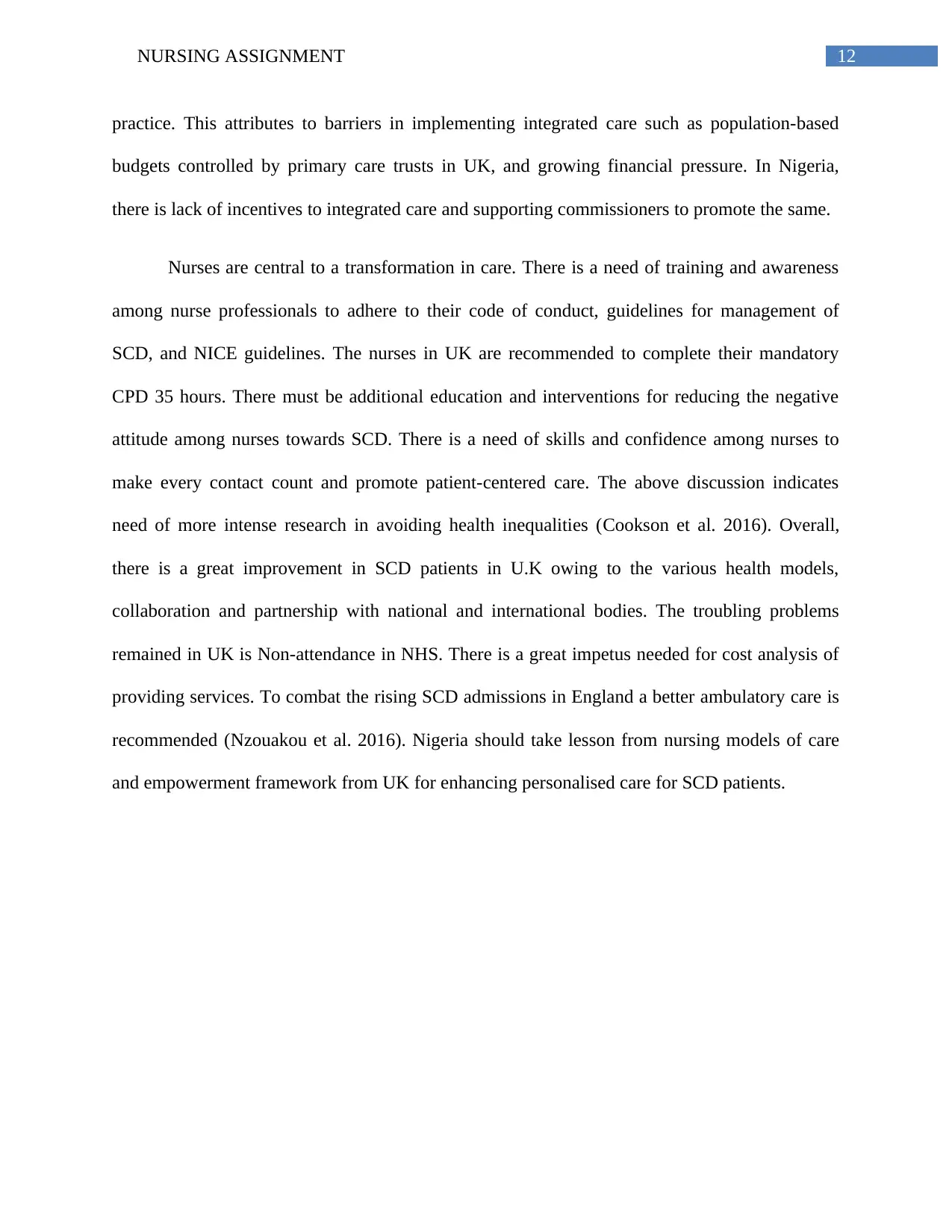
12NURSING ASSIGNMENT
practice. This attributes to barriers in implementing integrated care such as population-based
budgets controlled by primary care trusts in UK, and growing financial pressure. In Nigeria,
there is lack of incentives to integrated care and supporting commissioners to promote the same.
Nurses are central to a transformation in care. There is a need of training and awareness
among nurse professionals to adhere to their code of conduct, guidelines for management of
SCD, and NICE guidelines. The nurses in UK are recommended to complete their mandatory
CPD 35 hours. There must be additional education and interventions for reducing the negative
attitude among nurses towards SCD. There is a need of skills and confidence among nurses to
make every contact count and promote patient-centered care. The above discussion indicates
need of more intense research in avoiding health inequalities (Cookson et al. 2016). Overall,
there is a great improvement in SCD patients in U.K owing to the various health models,
collaboration and partnership with national and international bodies. The troubling problems
remained in UK is Non-attendance in NHS. There is a great impetus needed for cost analysis of
providing services. To combat the rising SCD admissions in England a better ambulatory care is
recommended (Nzouakou et al. 2016). Nigeria should take lesson from nursing models of care
and empowerment framework from UK for enhancing personalised care for SCD patients.
practice. This attributes to barriers in implementing integrated care such as population-based
budgets controlled by primary care trusts in UK, and growing financial pressure. In Nigeria,
there is lack of incentives to integrated care and supporting commissioners to promote the same.
Nurses are central to a transformation in care. There is a need of training and awareness
among nurse professionals to adhere to their code of conduct, guidelines for management of
SCD, and NICE guidelines. The nurses in UK are recommended to complete their mandatory
CPD 35 hours. There must be additional education and interventions for reducing the negative
attitude among nurses towards SCD. There is a need of skills and confidence among nurses to
make every contact count and promote patient-centered care. The above discussion indicates
need of more intense research in avoiding health inequalities (Cookson et al. 2016). Overall,
there is a great improvement in SCD patients in U.K owing to the various health models,
collaboration and partnership with national and international bodies. The troubling problems
remained in UK is Non-attendance in NHS. There is a great impetus needed for cost analysis of
providing services. To combat the rising SCD admissions in England a better ambulatory care is
recommended (Nzouakou et al. 2016). Nigeria should take lesson from nursing models of care
and empowerment framework from UK for enhancing personalised care for SCD patients.
Paraphrase This Document
Need a fresh take? Get an instant paraphrase of this document with our AI Paraphraser
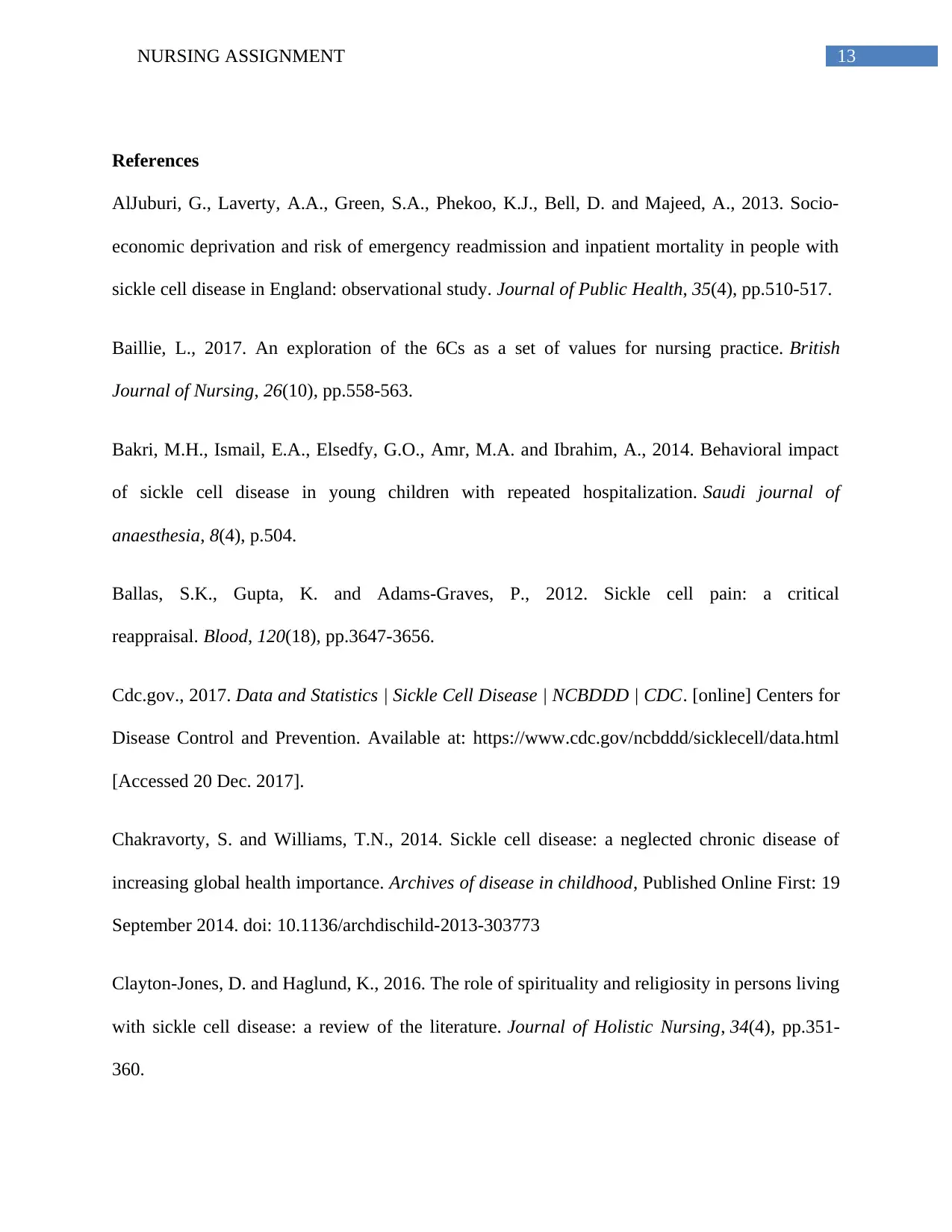
13NURSING ASSIGNMENT
References
AlJuburi, G., Laverty, A.A., Green, S.A., Phekoo, K.J., Bell, D. and Majeed, A., 2013. Socio-
economic deprivation and risk of emergency readmission and inpatient mortality in people with
sickle cell disease in England: observational study. Journal of Public Health, 35(4), pp.510-517.
Baillie, L., 2017. An exploration of the 6Cs as a set of values for nursing practice. British
Journal of Nursing, 26(10), pp.558-563.
Bakri, M.H., Ismail, E.A., Elsedfy, G.O., Amr, M.A. and Ibrahim, A., 2014. Behavioral impact
of sickle cell disease in young children with repeated hospitalization. Saudi journal of
anaesthesia, 8(4), p.504.
Ballas, S.K., Gupta, K. and Adams-Graves, P., 2012. Sickle cell pain: a critical
reappraisal. Blood, 120(18), pp.3647-3656.
Cdc.gov., 2017. Data and Statistics | Sickle Cell Disease | NCBDDD | CDC. [online] Centers for
Disease Control and Prevention. Available at: https://www.cdc.gov/ncbddd/sicklecell/data.html
[Accessed 20 Dec. 2017].
Chakravorty, S. and Williams, T.N., 2014. Sickle cell disease: a neglected chronic disease of
increasing global health importance. Archives of disease in childhood, Published Online First: 19
September 2014. doi: 10.1136/archdischild-2013-303773
Clayton-Jones, D. and Haglund, K., 2016. The role of spirituality and religiosity in persons living
with sickle cell disease: a review of the literature. Journal of Holistic Nursing, 34(4), pp.351-
360.
References
AlJuburi, G., Laverty, A.A., Green, S.A., Phekoo, K.J., Bell, D. and Majeed, A., 2013. Socio-
economic deprivation and risk of emergency readmission and inpatient mortality in people with
sickle cell disease in England: observational study. Journal of Public Health, 35(4), pp.510-517.
Baillie, L., 2017. An exploration of the 6Cs as a set of values for nursing practice. British
Journal of Nursing, 26(10), pp.558-563.
Bakri, M.H., Ismail, E.A., Elsedfy, G.O., Amr, M.A. and Ibrahim, A., 2014. Behavioral impact
of sickle cell disease in young children with repeated hospitalization. Saudi journal of
anaesthesia, 8(4), p.504.
Ballas, S.K., Gupta, K. and Adams-Graves, P., 2012. Sickle cell pain: a critical
reappraisal. Blood, 120(18), pp.3647-3656.
Cdc.gov., 2017. Data and Statistics | Sickle Cell Disease | NCBDDD | CDC. [online] Centers for
Disease Control and Prevention. Available at: https://www.cdc.gov/ncbddd/sicklecell/data.html
[Accessed 20 Dec. 2017].
Chakravorty, S. and Williams, T.N., 2014. Sickle cell disease: a neglected chronic disease of
increasing global health importance. Archives of disease in childhood, Published Online First: 19
September 2014. doi: 10.1136/archdischild-2013-303773
Clayton-Jones, D. and Haglund, K., 2016. The role of spirituality and religiosity in persons living
with sickle cell disease: a review of the literature. Journal of Holistic Nursing, 34(4), pp.351-
360.
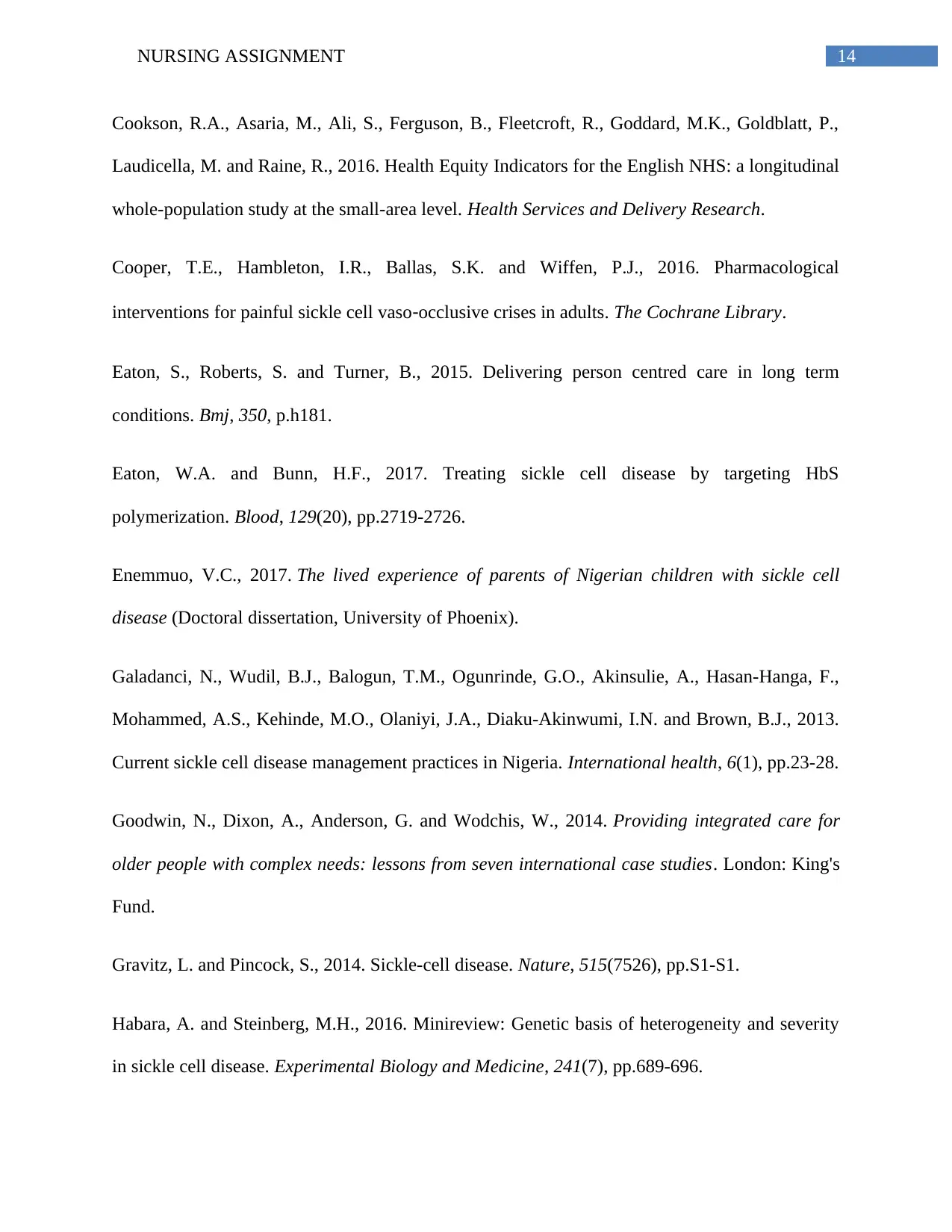
14NURSING ASSIGNMENT
Cookson, R.A., Asaria, M., Ali, S., Ferguson, B., Fleetcroft, R., Goddard, M.K., Goldblatt, P.,
Laudicella, M. and Raine, R., 2016. Health Equity Indicators for the English NHS: a longitudinal
whole-population study at the small-area level. Health Services and Delivery Research.
Cooper, T.E., Hambleton, I.R., Ballas, S.K. and Wiffen, P.J., 2016. Pharmacological
interventions for painful sickle cell vaso‐occlusive crises in adults. The Cochrane Library.
Eaton, S., Roberts, S. and Turner, B., 2015. Delivering person centred care in long term
conditions. Bmj, 350, p.h181.
Eaton, W.A. and Bunn, H.F., 2017. Treating sickle cell disease by targeting HbS
polymerization. Blood, 129(20), pp.2719-2726.
Enemmuo, V.C., 2017. The lived experience of parents of Nigerian children with sickle cell
disease (Doctoral dissertation, University of Phoenix).
Galadanci, N., Wudil, B.J., Balogun, T.M., Ogunrinde, G.O., Akinsulie, A., Hasan-Hanga, F.,
Mohammed, A.S., Kehinde, M.O., Olaniyi, J.A., Diaku-Akinwumi, I.N. and Brown, B.J., 2013.
Current sickle cell disease management practices in Nigeria. International health, 6(1), pp.23-28.
Goodwin, N., Dixon, A., Anderson, G. and Wodchis, W., 2014. Providing integrated care for
older people with complex needs: lessons from seven international case studies. London: King's
Fund.
Gravitz, L. and Pincock, S., 2014. Sickle-cell disease. Nature, 515(7526), pp.S1-S1.
Habara, A. and Steinberg, M.H., 2016. Minireview: Genetic basis of heterogeneity and severity
in sickle cell disease. Experimental Biology and Medicine, 241(7), pp.689-696.
Cookson, R.A., Asaria, M., Ali, S., Ferguson, B., Fleetcroft, R., Goddard, M.K., Goldblatt, P.,
Laudicella, M. and Raine, R., 2016. Health Equity Indicators for the English NHS: a longitudinal
whole-population study at the small-area level. Health Services and Delivery Research.
Cooper, T.E., Hambleton, I.R., Ballas, S.K. and Wiffen, P.J., 2016. Pharmacological
interventions for painful sickle cell vaso‐occlusive crises in adults. The Cochrane Library.
Eaton, S., Roberts, S. and Turner, B., 2015. Delivering person centred care in long term
conditions. Bmj, 350, p.h181.
Eaton, W.A. and Bunn, H.F., 2017. Treating sickle cell disease by targeting HbS
polymerization. Blood, 129(20), pp.2719-2726.
Enemmuo, V.C., 2017. The lived experience of parents of Nigerian children with sickle cell
disease (Doctoral dissertation, University of Phoenix).
Galadanci, N., Wudil, B.J., Balogun, T.M., Ogunrinde, G.O., Akinsulie, A., Hasan-Hanga, F.,
Mohammed, A.S., Kehinde, M.O., Olaniyi, J.A., Diaku-Akinwumi, I.N. and Brown, B.J., 2013.
Current sickle cell disease management practices in Nigeria. International health, 6(1), pp.23-28.
Goodwin, N., Dixon, A., Anderson, G. and Wodchis, W., 2014. Providing integrated care for
older people with complex needs: lessons from seven international case studies. London: King's
Fund.
Gravitz, L. and Pincock, S., 2014. Sickle-cell disease. Nature, 515(7526), pp.S1-S1.
Habara, A. and Steinberg, M.H., 2016. Minireview: Genetic basis of heterogeneity and severity
in sickle cell disease. Experimental Biology and Medicine, 241(7), pp.689-696.
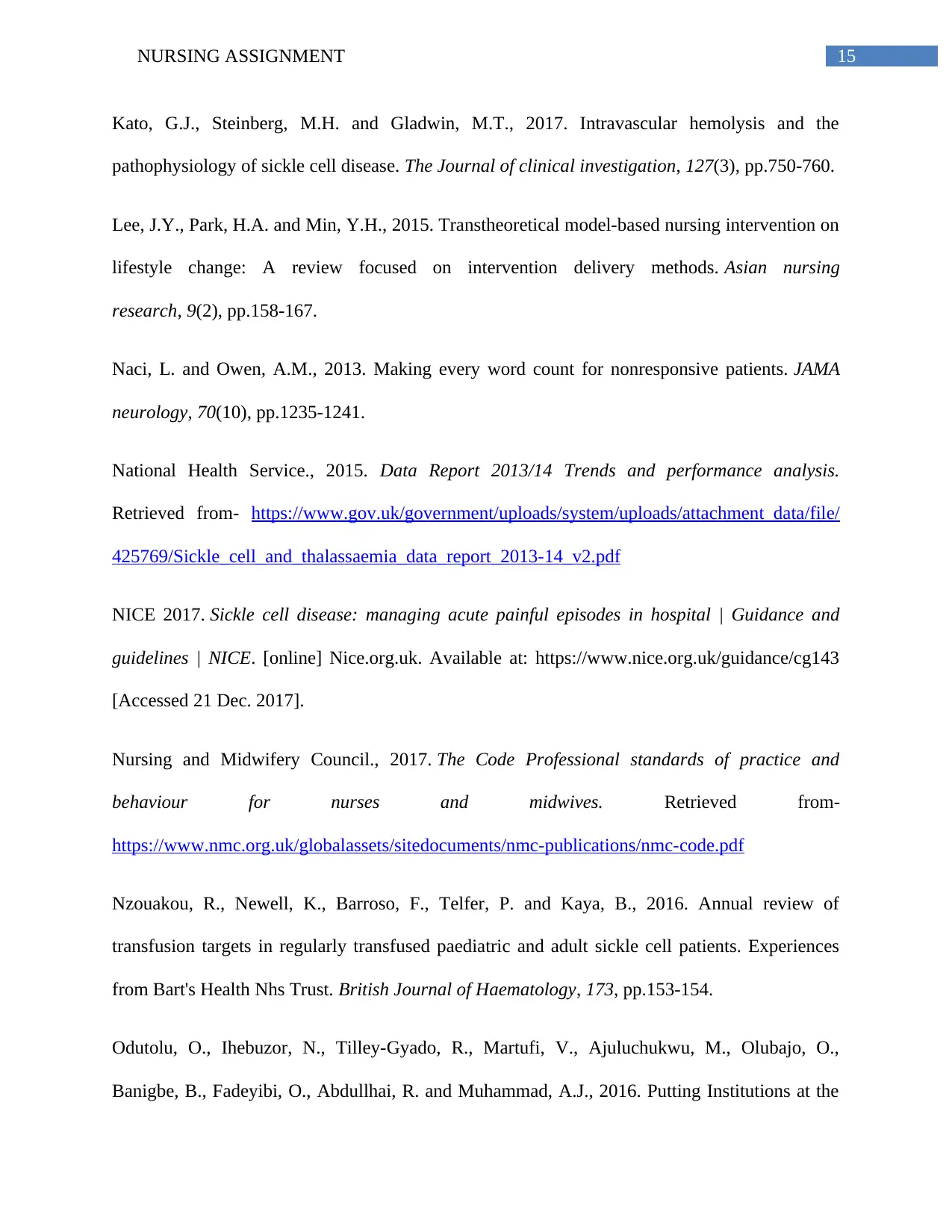
15NURSING ASSIGNMENT
Kato, G.J., Steinberg, M.H. and Gladwin, M.T., 2017. Intravascular hemolysis and the
pathophysiology of sickle cell disease. The Journal of clinical investigation, 127(3), pp.750-760.
Lee, J.Y., Park, H.A. and Min, Y.H., 2015. Transtheoretical model-based nursing intervention on
lifestyle change: A review focused on intervention delivery methods. Asian nursing
research, 9(2), pp.158-167.
Naci, L. and Owen, A.M., 2013. Making every word count for nonresponsive patients. JAMA
neurology, 70(10), pp.1235-1241.
National Health Service., 2015. Data Report 2013/14 Trends and performance analysis.
Retrieved from- https://www.gov.uk/government/uploads/system/uploads/attachment_data/file/
425769/Sickle_cell_and_thalassaemia_data_report_2013-14_v2.pdf
NICE 2017. Sickle cell disease: managing acute painful episodes in hospital | Guidance and
guidelines | NICE. [online] Nice.org.uk. Available at: https://www.nice.org.uk/guidance/cg143
[Accessed 21 Dec. 2017].
Nursing and Midwifery Council., 2017. The Code Professional standards of practice and
behaviour for nurses and midwives. Retrieved from-
https://www.nmc.org.uk/globalassets/sitedocuments/nmc-publications/nmc-code.pdf
Nzouakou, R., Newell, K., Barroso, F., Telfer, P. and Kaya, B., 2016. Annual review of
transfusion targets in regularly transfused paediatric and adult sickle cell patients. Experiences
from Bart's Health Nhs Trust. British Journal of Haematology, 173, pp.153-154.
Odutolu, O., Ihebuzor, N., Tilley-Gyado, R., Martufi, V., Ajuluchukwu, M., Olubajo, O.,
Banigbe, B., Fadeyibi, O., Abdullhai, R. and Muhammad, A.J., 2016. Putting Institutions at the
Kato, G.J., Steinberg, M.H. and Gladwin, M.T., 2017. Intravascular hemolysis and the
pathophysiology of sickle cell disease. The Journal of clinical investigation, 127(3), pp.750-760.
Lee, J.Y., Park, H.A. and Min, Y.H., 2015. Transtheoretical model-based nursing intervention on
lifestyle change: A review focused on intervention delivery methods. Asian nursing
research, 9(2), pp.158-167.
Naci, L. and Owen, A.M., 2013. Making every word count for nonresponsive patients. JAMA
neurology, 70(10), pp.1235-1241.
National Health Service., 2015. Data Report 2013/14 Trends and performance analysis.
Retrieved from- https://www.gov.uk/government/uploads/system/uploads/attachment_data/file/
425769/Sickle_cell_and_thalassaemia_data_report_2013-14_v2.pdf
NICE 2017. Sickle cell disease: managing acute painful episodes in hospital | Guidance and
guidelines | NICE. [online] Nice.org.uk. Available at: https://www.nice.org.uk/guidance/cg143
[Accessed 21 Dec. 2017].
Nursing and Midwifery Council., 2017. The Code Professional standards of practice and
behaviour for nurses and midwives. Retrieved from-
https://www.nmc.org.uk/globalassets/sitedocuments/nmc-publications/nmc-code.pdf
Nzouakou, R., Newell, K., Barroso, F., Telfer, P. and Kaya, B., 2016. Annual review of
transfusion targets in regularly transfused paediatric and adult sickle cell patients. Experiences
from Bart's Health Nhs Trust. British Journal of Haematology, 173, pp.153-154.
Odutolu, O., Ihebuzor, N., Tilley-Gyado, R., Martufi, V., Ajuluchukwu, M., Olubajo, O.,
Banigbe, B., Fadeyibi, O., Abdullhai, R. and Muhammad, A.J., 2016. Putting Institutions at the
Secure Best Marks with AI Grader
Need help grading? Try our AI Grader for instant feedback on your assignments.

16NURSING ASSIGNMENT
Center of Primary Health Care Reforms: Experience from Implementation in Three States in
Nigeria. Health Systems & Reform, 2(4), pp.290-301.
Olagunju, O., Olaogun, A., Afolabi, E. and Adereti, S., 2014. Psychosocial problems of sickle
cell disease as experienced by primary paediatric carers in southwest Nigeria. African Journal of
Midwifery & Women's Health, 8(1).
Olatunya, O.S. and Adekile, A.D., 2017. Letter to Editor: What every physician should know
about the national guidelines for the control and management of sickle cell disease and the parent
handbook for sickle cell disease in Nigeria. Nigerian journal of clinical practice, 20(1), pp.123-
125.
Piel, F.B., Hay, S.I., Gupta, S., Weatherall, D.J. and Williams, T.N., 2013. Global burden of
sickle cell anaemia in children under five, 2010–2050: modelling based on demographics, excess
mortality, and interventions. PLoS medicine, 10(7), p.e1001484.
Piel, F.B., Rees, D.C. and Williams, T.N., 2014. Managing the burden of sickle-cell disease in
Africa. The Lancet Haematology, 1(1), pp.e11-e12.
Sainati, L., Montanaro, M. and Colombatti, R., 2016. A Global Perspective on Milestones of
Care for Children with Sickle Cell Disease. In Sickle Cell Disease-Pain and Common Chronic
Complications. InTech.
Salway, S., Mir, G., Turner, D., Ellison, G.T., Carter, L. and Gerrish, K., 2016. Obstacles to
“race equality” in the English National Health Service: Insights from the healthcare
commissioning arena. Social Science & Medicine, 152, pp.102-110.
Center of Primary Health Care Reforms: Experience from Implementation in Three States in
Nigeria. Health Systems & Reform, 2(4), pp.290-301.
Olagunju, O., Olaogun, A., Afolabi, E. and Adereti, S., 2014. Psychosocial problems of sickle
cell disease as experienced by primary paediatric carers in southwest Nigeria. African Journal of
Midwifery & Women's Health, 8(1).
Olatunya, O.S. and Adekile, A.D., 2017. Letter to Editor: What every physician should know
about the national guidelines for the control and management of sickle cell disease and the parent
handbook for sickle cell disease in Nigeria. Nigerian journal of clinical practice, 20(1), pp.123-
125.
Piel, F.B., Hay, S.I., Gupta, S., Weatherall, D.J. and Williams, T.N., 2013. Global burden of
sickle cell anaemia in children under five, 2010–2050: modelling based on demographics, excess
mortality, and interventions. PLoS medicine, 10(7), p.e1001484.
Piel, F.B., Rees, D.C. and Williams, T.N., 2014. Managing the burden of sickle-cell disease in
Africa. The Lancet Haematology, 1(1), pp.e11-e12.
Sainati, L., Montanaro, M. and Colombatti, R., 2016. A Global Perspective on Milestones of
Care for Children with Sickle Cell Disease. In Sickle Cell Disease-Pain and Common Chronic
Complications. InTech.
Salway, S., Mir, G., Turner, D., Ellison, G.T., Carter, L. and Gerrish, K., 2016. Obstacles to
“race equality” in the English National Health Service: Insights from the healthcare
commissioning arena. Social Science & Medicine, 152, pp.102-110.
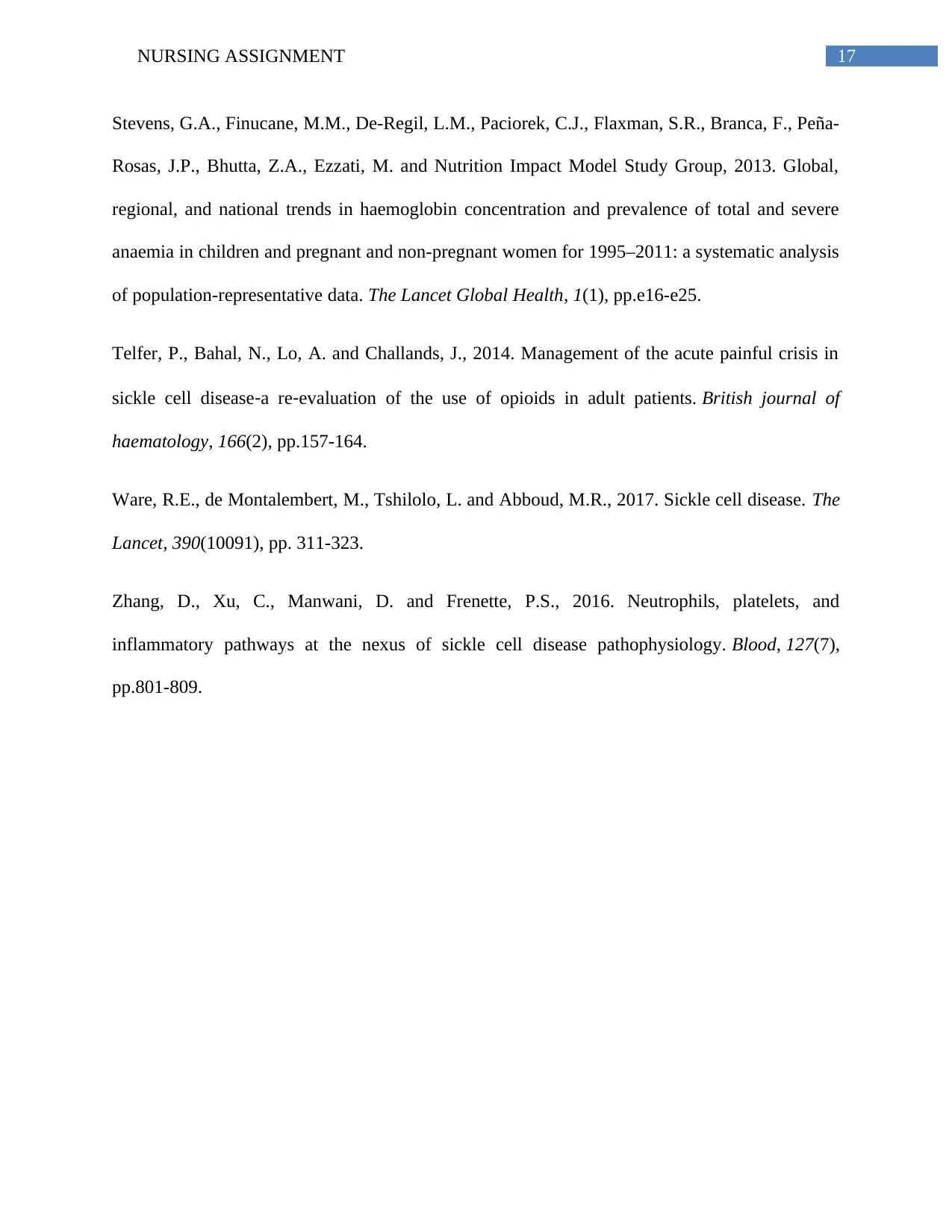
17NURSING ASSIGNMENT
Stevens, G.A., Finucane, M.M., De-Regil, L.M., Paciorek, C.J., Flaxman, S.R., Branca, F., Peña-
Rosas, J.P., Bhutta, Z.A., Ezzati, M. and Nutrition Impact Model Study Group, 2013. Global,
regional, and national trends in haemoglobin concentration and prevalence of total and severe
anaemia in children and pregnant and non-pregnant women for 1995–2011: a systematic analysis
of population-representative data. The Lancet Global Health, 1(1), pp.e16-e25.
Telfer, P., Bahal, N., Lo, A. and Challands, J., 2014. Management of the acute painful crisis in
sickle cell disease‐a re‐evaluation of the use of opioids in adult patients. British journal of
haematology, 166(2), pp.157-164.
Ware, R.E., de Montalembert, M., Tshilolo, L. and Abboud, M.R., 2017. Sickle cell disease. The
Lancet, 390(10091), pp. 311-323.
Zhang, D., Xu, C., Manwani, D. and Frenette, P.S., 2016. Neutrophils, platelets, and
inflammatory pathways at the nexus of sickle cell disease pathophysiology. Blood, 127(7),
pp.801-809.
Stevens, G.A., Finucane, M.M., De-Regil, L.M., Paciorek, C.J., Flaxman, S.R., Branca, F., Peña-
Rosas, J.P., Bhutta, Z.A., Ezzati, M. and Nutrition Impact Model Study Group, 2013. Global,
regional, and national trends in haemoglobin concentration and prevalence of total and severe
anaemia in children and pregnant and non-pregnant women for 1995–2011: a systematic analysis
of population-representative data. The Lancet Global Health, 1(1), pp.e16-e25.
Telfer, P., Bahal, N., Lo, A. and Challands, J., 2014. Management of the acute painful crisis in
sickle cell disease‐a re‐evaluation of the use of opioids in adult patients. British journal of
haematology, 166(2), pp.157-164.
Ware, R.E., de Montalembert, M., Tshilolo, L. and Abboud, M.R., 2017. Sickle cell disease. The
Lancet, 390(10091), pp. 311-323.
Zhang, D., Xu, C., Manwani, D. and Frenette, P.S., 2016. Neutrophils, platelets, and
inflammatory pathways at the nexus of sickle cell disease pathophysiology. Blood, 127(7),
pp.801-809.
1 out of 18
Related Documents
Your All-in-One AI-Powered Toolkit for Academic Success.
+13062052269
info@desklib.com
Available 24*7 on WhatsApp / Email
![[object Object]](/_next/static/media/star-bottom.7253800d.svg)
Unlock your academic potential
© 2024 | Zucol Services PVT LTD | All rights reserved.




